Fall 2019
Greetings colleagues, friends of HU, and Regents. A brief update for the week December 16-20—a little early due to a board meeting tomorrow. Also, the last weekly message for this term and the last indefinitely. The legislative session will begin in January making for additional travel, meetings, and less time for other activities. I try to do my weekly messages in the early a.m. or after regular work hours, but spending so much time in Santa Fe requires early morning I-25 drives and late returns to Las Vegas. Of course, I will provide critical information to the campus community as things arise. Community members may check the NMHU News site for various campus updates.
1. I had dinner with the governor this week. We spoke of several initiatives—mostly the Opportunity Scholarship program, the CUP’s legislative requests, and the governor’s vision for preK-16 education in New Mexico. It was a good and positive meeting and I appreciated the governor taking time in her busy schedule to meet with us. The CUP presidents, CUP Director Mr. Marc Saavedra (far right), and the governor:
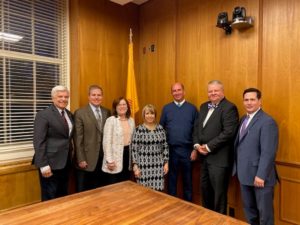
2. I moved back over to Rodgers this week and from now on I’ll be there if you want or need to see me. The physical configuration is a little different over there, but my standard remains the same—if my door is open and I’m not meeting with someone or on the phone, I’ll see you then. Of course, you can make an appointment with Caro if you’d prefer to go that way. We’ll have a ribbon cutting at some point in Rodgers, but please feel free to walk in and take a look. Absolutely fabulous.
3. We’ll be installing some new windows in Wilson over the break. The windows are in very poor repair and some are broken. The new windows will make classes and other activities in Wilson much more appealing. The crew getting ready for the installation:

4. The National Student Clearinghouse Research Center has compiled information about fall college and university enrollments and fall enrollment nationally has declined for the eighth consecutive year. Institutions of every type experienced a decline—public schools, private schools, online schools, etc. The state experiencing the largest percent decrease from last year was Wyoming (-4.9). Alaska and New Mexico were tied for the second largest decline at -4.3%. Florida lost the largest number of total students—a decline of 52,328. First-time enrollments for 18-24 year old students decreased at all institutions. The state with the top growth? Utah. Higher education officials in that state have suggested that the growth is mainly due to more and better online programs and additional services to adult students and program completers. Of course, another issue is that many communities in Utah are rapidly growing. Dixie State University is located in St. George, Utah and St. George was recently declared the fourth fastest-growing metropolitan area in the United States. When populations are rapidly growing, enrollment in institutions of higher education tend to go up. When population is flat or declining, college enrollment tends to go down. Last year (2018), the overall population growth rate in new Mexico was 0.6 and that minimal growth was concentrated in only a few areas.
5. The University of Texas at San Antonio is the latest Texas school to offer free tuition. The program was announced last week. Beginning in the fall term 2020, UT San Antonio will cover 100% of tuition and fees for eight semesters. To be eligible, students must be Texas residents, in the top 25% of their high school class, complete the FAFSA, and enroll full time each semester. Other Texas colleges and universities already offer some form of free tuition including Texas A&M, UT Austin, and UT Rio Grande Valley. For more, go to: https://www.statesman.com/news/20191212/ut-san-antonio-announces-free-tuition-for-freshmen-whose-families-make-50500-or-less
UT San Antonio announces free tuition for freshmen whose families make $50,500 or less – News – Austin American-Statesman – Austin, TX
The University of Texas San Antonio on Thursday became the latest college in Texas to offer free tuition for students from low-income families. Also last week, a community college in Indiana announced that it will provide free tuition to volunteer firefighters and EMS personnel.
6. The U.S. House of Representatives passed a budget this week and it is expected to also pass in the Senate. The budget includes a modest increase in Pell funding—a $150 increase bringing the maximum award to $6,345. HU’s tuition and fees for 2019-2020 is less than the maximum Pell award. In other words, if a student receives the maximum Pell award, they attend HU (tuition and fees) at no cost. Of course, not every student receives the maximum Pell award.
7. The fall term, 2019 is at and end and it has been a mostly good one for HU. We started the fall semester with an improving financial picture in the state resulting in decent (the best in many years) compensation increases for our employees, some new money for operations, and some resources to make some much needed repairs on the campus. In my view, we’ve not been in better financial shape since I’ve been here. We have taken care of several significant and lingering fiscal issues and improved our bottom line through fiscal restraint and careful stewardship. This week we finalized the report we’ll submit to the HLC in preparation for their March visit and among several fiscal issues, we noted a FY 18 Consolidated Fiscal Index (the CFI is the most common overall measure of fiscal health) of 2.27. That’s up from the FY12 CFI of .01. Our accreditor asked us to demonstrate less reliance on state funding and we’ll be able to make a great argument in that domain—we have modestly increased tuition to make us less reliant on volatile state funding and yet we remain one of the most affordable schools in the state and in the Southwest. Bottom line—our fiscal house is in order and improving over time. We have finished the second historical building renovation over the past several years—the McCaffrey Historic Trolley Building was finished my first year here and now Rodgers Hall is done— both on time and in budget and both simply magnificent. Two important academic programs have recently won specialty accreditations (education and forestry) and both garnered very positive reviews. Those two particular specialty accreditations are not all that easy to win and we have had some historical challenges with both of them, but we now have achieved those specialty accreditations and are moving forward. We started our new MFA program this fall and the Media Arts program continues to do great things and win rave reviews. We continue to be known as the premiere social work program in the state and this fall term began the development of a new social work initiative to more powerfully serve Native American families. Our new online alternative teacher education program is doing very well and last week, our foresters won a $5mil grant—one of the largest awards in HU’s history. A few weeks ago, we had a very positive visit from representatives of the Sherman Fairchild Foundation and I am hopeful we’ll win that important award. We’ll hear soon on that. Last year, our advancement team exceeded their goal ($2mil) and a few days ago, HU Advancement brought in more than $320K on Giving Tuesday. That’s 320K in a single day. We have high functioning boards in the foundation and alumni affairs and our H Club is doing great things to support HU athletics. Our Office of Outdoor Recreation continues to provide incredible value to our students and many of the excursions we do (e.g., ski trips, etc.) are fully booked. Last year was a historic one for HU athletics—winners of the RMAC (men’s basketball) for the first time in our 125+ year history. We also produced an NCAA Division II woman’s champ and our beloved Vatos once again won the small college national championship. A few days ago we had a wonderful championship ring ceremony for those student athletes. We are trending upward in several retention areas. We have recommitted to our roots by institutionalizing a biennial matanza (the next one will be fall 2020) and supporting our wonderful mariachi troupe. We are directly addressing the extreme shortage of potential Hispanic higher education executives by supporting one of our own, Dr. Martinez, at an ACE Fellowship. However, like all institutions of higher education, HU faces many challenges. Although our bottom line is improving, it is a constant challenge to find the resources to do what we must and certainly what we’d like to do. Enrollment is also a constant challenge, but given the fact that university enrollments nationwide are down for the eighth consecutive year, I don’t imagine anyone is surprised by that particular challenge. Compensation is improving, but again, HU like all institutions of higher education in New Mexico, lags behind our peers making for many challenges in both faculty recruitment and retention. Salaries for other HU employees also lag compared to peers. And, of course, this semester we experienced the cyber-attack. That was really tough and we are still dealing with the fallout of that. And yet…it was really a beautiful thing to see so many people come together to get us back up and running and taking care of the real business of HU—teaching, learning, research, and making the world a better place one student at a time. Helping our students graduate, win a good first destination job or graduate school placement, go on to have a great work career, and to help them live lives of purpose and meaning. I’m not sure I have ever seen the HU spirit more powerfully manifested than after the attack. It was really gratifying.
The spring term will bring new challenges and opportunities. Our focused HLC visit is important and we must do well. The new strategic plan is coming along—largely driven by those will implement it—that is to say, the faculty—and we should finish the plan by the end of the 19-20 academic year. It is important that we continue to develop new programs and several are in the works, but there are opportunities for even more. I look forward to solving our challenges and engaging in the opportunities before us. As always, it is a great pleasure to serve HU, to be the best servant leader I can be, and to be even a small part of our students’ success stories. I thank you, my colleagues, for allowing me those opportunities. I hope your holiday break is filled with some well-deserved R&R, maybe a good book or a film or two, and some time with friends and family. Let’s make 2020 a great year for HU and our students.
Happy holidays to all.
Sam Minner,
President
Greetings colleagues. A brief update for the week December 9-13:
1. I spent some time in Santa Fe this week and I learned that projected state revenue is down a bit. However, there is still going to be some new money available this year. Many agencies are making large requests—-PED among them. Please be assured that the Council of University Presidents is doing and will do all we can to attempt to transfer some of the new dollars to higher education.
2. This has been an extraordinary week for our forestry program. In 2008, the Society of American Foresters granted Candidacy for Accreditation to the forestry program. Progress reports were filed in 2009, 2010, 2011, and 2012. In 2013 the program was granted provisional accreditation subject to several requirements and again, progress reports were submitted in 2015, 2016, and 2017. For several reasons, accreditation was postponed at that point. But, this week we were informed that the program is now accredited through December 31, 2029. Well done to everyone who made this happen. In addition to this good news, we were also informed that HU has been awarded a grant titled “CREST Center for Forest Restoration Triangle” in the amount $4,997,141. The grant will be directed by Kent Reid, Owen Burney, Blanca Cespedes, and Craig Conley. This is one of the largest awards HU has ever received. Money will go to student support, equipment, faculty support, and other categories. HU will accrue approximately $200K in indirect support of this grant. Again, well done to all.
3. I finally received some information about the Governor’s proposed Opportunity Scholarship program. It is attached (above) along with the presentation the CUP made at the LFC hearing. You can read it for yourself, but a few critical details:
a. The Governor plans to fund this program at $35mil per year.
b. Returning students (adults) may participate in the program, but must be at least 24 years old.
c. MOUs between HED and all institutions of higher education will be negotiated and may include some tuition cap.
4. HU is once again supporting the Highlands Legislative Fellowship Program during this year’s legislative session. About 12 HU students are participating in the program which includes extensive seminars and lectures focusing on the legislative process and leadership development generally. The Fellows will spend time at the session including meetings of the Legislative Finance Committee, private meetings with numerous elected officials, and various tours and behind-the scenes experiences related to the legislative process. Many thanks to the HU faculty and staff who are devoting time to this initiative including Dr. Elaine Rodriguez, Dr. Denise Montoya, Dr. Kim Blea, and Max Baca. I was at lunch with them this week and wow…what a wonderful group of students and what incredible representatives of HU. The Fellows were in Santa Fe this week to observe the LFC hearings. A few photos of them at lunch and in the gallery of the Roundhouse:
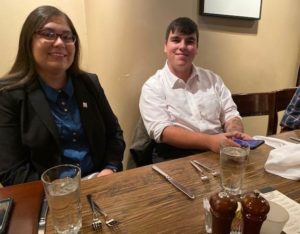
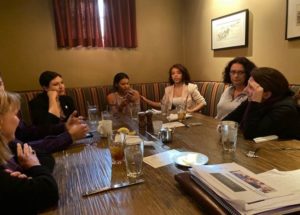
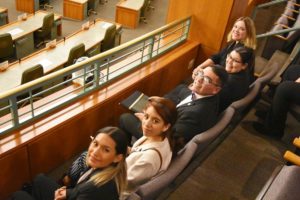
5. We received our IPEDS Data Feedback Report this week and it revealed some interesting facts. The comparisons are to our self-identified peers. Those are Adams State University (Alamosa, CO), Alcorn State University (Alcorn State, MS), Colorado State University-Pueblo (Pueblo, CO), East Central University (Ada, OK), Eastern New Mexico University-Main Campus (Portales, NM), Lincoln University (Lincoln University, PA), Northeastern State University (Tahlequah, OK), Sul Ross State University (Alpine, TX), The University of Texas of the Permian Basin (Odessa, TX), University of West Alabama (Livingston, AL), and Western New Mexico University (Silver City, NM). Among the findings:
• Compared to our peer institutions, the HU student body is much more diverse.
• Our overall enrollment is significantly less than our peer average, but our number of graduates is significantly higher.
• HU is still a bargain compared with our peers.
• A higher percentage of our first-time freshmen receive institutional aid, but the average award amount is smaller.
• A much lower percentage of our first-time students take out loans.
• A significantly higher percentage of our first-time students are Pell recipients.
• Graduation rates for transfer students are comparable to or higher than for our peers.
• Faculty salaries at HU are slightly lower than for peer institutions.
6. Everyone at HU is so proud of our wonderful Foundation Board President, Ms. Tina Cordova, for her nomination for the 2019 Arms Control Association (ACA) Person of the Year. Every year, the ACA nominates a select group of individuals who raise awareness of the threats posed by mass casualty weapons. This year, several distinguished groups or people have been nominated including Senator Michael Dembrow for his efforts to reduce the threat of nuclear war, Afghanistan’s first all-female de-mining team to remove landmines from a province in Afghanistan, the Swedish Ministry of Foreign Affairs for its work toward nuclear disarmament, and Tina’s work on behalf of the Tularosa Basin Downwinders. Here’s the information from ACA’s website noting why Tina is worthy of this award:
Tina Cordova of the Tularosa Basin Downwinders Consortium for her steadfast advocacy to include downwinders in New Mexico near the July 15, 1945 Trinity nuclear test explosion to be eligible for compensation and recognition under Radiation Exposure Compensation Act (RECA). As we mark the 75th anniversary of the nuclear test explosion that ignited the nuclear age, we want to recognize this effort along with the broader campaign to include other exposed downwinder and uranium worker communities seeking compensation and recognition under RECA
So proud of you Tina. Well done.
7. HU Advancement continues to perform at a high level. This week we accrued a gift of $25,000 in support of Media Arts and a $5000 gift to support low-income students interested in STEM majors. Well done.
The last Americana radio show of the fall term: https://www.dropbox.com/s/queqj3d467c1l1k/big-sam-number-4.mp3?dl=0
Sam Minner,
President
Greetings colleagues. A brief update for the week December 2-6—a little late due to being away from campus a bit:
1. As we get closer to this year’s legislative session, the discussions about the free college proposal seem to be growing more intense. I’ve heard a few arguments for and against free college generally, but most discussions I’ve heard seem to focus on the logistics of somehow and someway doing free college—how it works or might work and the possible pitfalls of various approaches. Here’s a good article from Forbes: https://www.forbes.com/sites/michaelhorn/2019/07/16/five-reasons-why-free-college-doesnt-make-the-grade/#26786eba6c1e. A very common concern about most free college proposals is that they simply do not address the real barriers so many poor (and some other) students face to get enrolled in the first place and to complete. If we are talking about community colleges, that’s basically free in many states right now. But….many of those students face other very daunting financial challenges like daycare, transportation, food insecurity, health disparities, care for elderly or disabled family members, and basically the financial and logistical realities of living a life. Of course, that is also true for many students at four-year schools too…like HU. Here’s a quote from the article in the event you don’t care to read the whole thing, “Most free college policies are regressive and don’t cover the costs that matter for students. Making tuition and fees free to students is unlikely to move the needle much in terms of completion, as community college is already free to low-income students, where it is covered by the federal government’s Pell Grants, and yet we continue to see paltry completion rates. The policy proposals offered don’t address other costs that impact low-income students, such as those for food, health care, childcare and the like. Instead, many free college proposals merely subsidize access for middle- and upper-income students.”
2. Many thanks to the individuals who attended the first “A Day In The Life” session on Monday afternoon. I learned about this concept in The Chronicle of Higher Education. The story was about MIT and their “day in the life” series where staff, faculty, and students are invited to luncheons where someone—usually an administrator of some kind with some strange title—talked about their job and what a day in their life was like. On Monday, I talked about my job here at Highlands. I went over one of my weekly calendars and spent a little time talking about how the university presidency has evolved over the years. We’ll do several other sessions during the spring term. Many thanks to Dr. Lauren Fath for organizing this series and thanks again to the people who attended. Sodexo provided a nice lunch so thanks to them as well.
3. We are moving forward on our emergency response processes and services by considering an emergency alert system that is vastly superior to what we have in place now. It will allow Sean Weaver’s office to send messages to multiple platforms (e.g., email, social media, texts, reverse calls, etc.) with one action, greatly improving our response and notification time (no more waiting hours for the text queue to be delivered). The Emergency Management Committee will soon meet with the vendor, and we hope to have this in place by January. Also in the University Relations domain, we recently purchased a service package that will help us more effectively disseminate our news releases and promote faculty accomplishments. The first part uses AI to identify students in press releases and sends notifications to each student’s hometown newspaper, parents, and elective officials. The faculty portion on the service makes it easy for faculty members to set up robust faculty pages that automatically update from our news feed. For example, when Margaret writes a story about a grant Mike Petronis received, that release will automatically show up on his faculty page.
4. We recently concluded two important searches at HU—the AD and the new and full-time Director of Title IX. Our new AD is Andrew Ehling who commented, “I can’t wait to get started. To me it’s important to both challenge and support student athletes. The dynamic is challenging, but that’s when you build those relationships that help them achieve their academic, athletic and social goals.” Ehling comes to Highlands University from McPherson College in Kansas, where he serves as their director of athletics. During his four-year tenure at the college, Ehling has helped raise more than $500,000 in 2018-19 for the program, maintained a strong retention rate for student-athletes, and saw several championship firsts for the college. Ehling said building a strong athletics program at Highlands will be a team effort. “There’s a lot of work to do, and that’s exciting to me” he said. “There’s tremendous opportunity to elevate Highlands from an athletics perspective. Ehling said he wanted to work at Highlands because of the opportunity and surrounding area. He is an avid outdoorsman. Before assuming the athletic director role at McPherson College, Ehling coached baseball teams at McPherson, the University of Central Missouri, Odessa College and served as the student assistant baseball coach at Kansas State University. We also recently came to terms with our new Title IX Director. She is very experienced in EEOC and related Title IX issues and had extensive experience with NYC unions. She is a great hire for us. We’ll send out an announcement once she has an opportunity to talk with her current employer.
5. On Tuesday we held the regular EMT meeting. We read a brief piece about the possibility of a “Blockbuster Moment” in American higher education. As you may already know, Blockbuster (remember late fees?…I once paid about 100 bucks for the movie Congo that our young son had “lost” under his bed and believe me, I was not happy about it) had a chance to purchase Netflix in 2000 for about $50 million. Today—nineteen years later—Netflix is valued around $138 billion. That’s billion with a B. Blockbuster went bankrupt. Not a one around. The author’s point in all this, “Just like brick-and-mortar video stores, almost every high-price/residential master’s program will disappear.” Predictions of gloom and doom are common in the higher education sector. Many of our colleagues are pretty good at making them—but not so great at accurate predictions. Perhaps the most famous prediction of that type was offered by the Harvard business professor, Clayton Christensen, who asserted,” …that half (of all bricks and mortar universities) are bound for bankruptcy in the next few decades.” Of course, that prediction was made some time ago. It didn’t really come to pass. Here’s the entire article from Inside Higher Education if you care to peruse: https://www.insidehighered.com/blogs/technology-and-learning/netflix-low-cost-online-masters-programs-and-will-never-work%E2%80%99 . The article generated many online comments including this one, “One of the things you can’t get online that you can face-to-face is a professor who gets to know you as a human being and can mentor you. Sure, online relationships can be formed, but if the point of doing them is to have more students, then the professor will, out of necessity, become less engaged with individuals. The problem with the comparison of Blockbuster/Netflix to masters education (in any field) is that education is NOT a business, regardless of how universities are being run. It’s a public good and a personal transformation — you can find very little public good and personal transformation online.”
6. Also on Tuesday, we held the Championship Ring Ceremony in the SUB. I was not able to attend the event and I regret that very much. We honored Ms. Annie Topal, our NCAA National Champ, our Cowboy men’s basketball team—last year’s RMAC champions, and the Vatos—last year’s NSCRO National champs (for the third time since I’ve been here). More than 200 people attended this upbeat event to honor our wonderful student athletes. Last year was a historic season for HU athletics—lots of great individual and team achievements. Just as is the case in regard to our academic mission, HU faces many challenges when it comes to “competing” with other schools in the athletic domain. Our NCAA teams compete in the RMAC and that’s one of the most competitive DII conferences in the nation. In many cases, RMAC schools (mostly in Colorado) have many many (one more…many) more resources than HU. If you are in Colorado Springs, take a look at the athletic facilities at UCCS. Contrast that with what we can afford here at HU. I often comment that one of our competitors in the RMAC has a budget about $30mil more every year than HU….30mil more each and every year. With that level of support, HU could build a new building or two every year or provide 10K raises to all faculty for multiple years and on and on. The Vatos commonly compete against teams from Duke, Penn, UNM, the University of Arizona, Bucknell, Ithaca, and other top tier publics and privates. The bottom line for me is…universities and individual people on this earth don’t always have the same level of support. A few are wealthy. Most are not. Due to intentional design, luck or whatever, some simply have more resources than others. That’s maybe too bad, but true. And yet….sometimes due to incredible commitment, ingenuity, very hard work, and going deep into the spirit of people facing long odds—universities and some individual people without the advantages others sometimes, somehow, and someway prevail. When that happens it is a beautiful thing. When it happens, it gives me great hope. And that really happened on the HU campus last year. We should be proud of the efforts of these student athletes, their coaches, and their many supporters. Go Cowgirls. Go Cowboys. Go Vatos. Go HU. Left photo of the Cowboys basketball team. Right photo of our wonderful coaches and Ms. Topal. And bottom photo the Vatos sporting their bling.
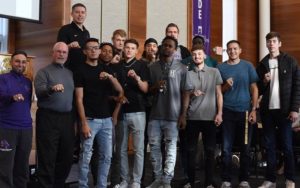
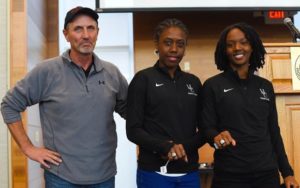
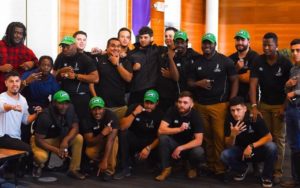
7. Giving Tuesday was this week and I am very pleased to announce that our Advancement Office collected $323,735 on that day. This is 100 times more than what we did in our first Giving Tuesday campaign. Donors could give to any HU program or initiative, but we highlighted three area—our work on the Rio Mora Refuge, the student emergency fund, and HU athletics. It was truly a Red Letter Day for HU Advancement and HU generally. Thanks so much to our wonderful advancement team and of course, our many and most generous donors.
8. Many thanks to all who visited the University Residence last Thursday for the annual Holiday Open House. Special thanks to Max and Sylvia Baca, Carolina Martinez, and Roxanne Gonzales for hosting the event in my absence.
The latest and final (for the fall term) installment of the Americana radio show: https://www.dropbox.com/s/queqj3d467c1l1k/big-sam-number-4.mp3?dl=0
Sam Minner,
President
Greetings colleagues. A brief update for the week of November 25-29.
This was a short week due to Thanksgiving.
1. Last weekend was a busy one. Joan and I attended the first half of the final football game of the year, listened to the basketball game online while driving down to Albuquerque, and arrived in time to attend the 2019 Montezuma Ball at the Hotel Albuquerque. The Montezuma Ball is an annual event sponsored by Dual Language Education of New Mexico. This year, Junior Achievement and Heritage Hotels co-sponsored the event. The Ball is a celebration of dual language education in our state and always draws a large and festive crowd. This year’s theme was Viva la Cultura. A photo of some of the HU contingent and the Albuquerque High School mariachi group:
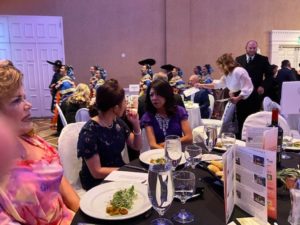
2. I and many others are looking forward to the upcoming legislative session including what I think will be a spirited discussion of the free college proposal. As many know and as I have previously noted in some of my weekly messages, the free college concept has been implemented in many nations. Here’s a brief update on how the free college program is going in Chile. That program is referred to as gratuidad: https://apple.news/Ad-pYSHHHR_2jtd6fpTfpGw
What The U.S. Can Learn From Free College In Chile — NPR
In 2016, Chile passed gratuidad, or “free college.” As the idea gains popularity ahead of the 2020 presidential election in the U.S., Chile offers some lessons from what has happened there.
3. I’ve heard the phrase “Las Vegas Renaissance” several times over the last several months and it does seem to me that the phrase has some validity. We have a number of younger entrepreneurs doing well in town with perhaps more on the way, the Castaneda is now open, and from my perspective at least, there is more of a “can do” feeling than in the past. There’s probably no group with the winning track record of getting things done in town than Main Street de Las Vegas. That nonprofit agency recently received a $48,000 grant from the city to win a $400,000 grant for improvements in the railroad district. I have served on the MSLV board for more than three years now and it has truly been a great pleasure. As my dad used to say, “After all is said and done, more will be said than done” and that is true when it comes to moving things forward. But I must say, when it comes to Main Street, some is said but even more is done…so well done to MSLV.
I hope everyone has a well-deserved holiday break. There’s not a lot left of the fall term remaining, but as always, there is much work to be done in these final weeks. As I reflect on the things I am thankful for, being allowed to serve HU as best I can is at the top of the list. We have an important and I would say even noble mission here and I truly feel we are the very center of contemporary and important issues in American higher ed. America has always done a good job educating certain segments of the population and we still do a good job there. However, when it comes to other individuals and groups, America has not done so well and in some cases, those folks have not even been welcomed. Our daily work is essentially an attempt to change all that. We welcome all and engage them in such a way to encourage, support, and do all we can to make certain they feel welcomed. Helping them graduate from HU, achieve good first destination outcomes, great careers, and the ability to live lives of deep purpose and meaning are our goals. It can be tough work, but…..it is so deeply gratifying. I thank you, my colleagues, for the opportunity to be a part of that.
Sam Minner,
President
Greetings colleagues. A brief update for the week November 18-22:
1. Our most recent promotional/recruitment piece developed by our Office of University Relations: https://www.facebook.com/HighlandsUniversity/videos/555587151909311/?epa=SEARCH_BOX . We’ll use this in recruitment and other promotional activities. A job well done Sean.
2. I held another “Lunch & Listen” session this week—this one with the Department of Psychology. I’ve done many of these now and they have been helpful to increase my understanding of what goes on in different offices, departments, etc. The Psych Department is really strong—faculty dedicated to our mission, highly collegial, and doing whatever it takes to get the job done. It was a really nice meeting and I thank my colleagues for taking the time to meet with me.
3. The most recent Performance Effectiveness Report (PEP) was released late last week. Some data from that publication:
a. all four year schools enrolled fewer students over the last three years with UNM experiencing the greatest decrease—a 14.3% reduction in FTE students over that period (p.iii)
b. over the academic year 2008-2009 to 2017-2018, the percentage of the NM general fund devoted to higher education fell from 14.9% to 12.3% (p. iv)
c. every institution in New Mexico has improved retention and completion rates over the past five years (p. viii)
d. despite declines in enrollment, the number of degrees awarded from New Mexico four year schools increased by 2.9% over the last five years (p. viii)
e. the average tuition at New Mexico four year universities is about 30% less than the national average and the fifth lowest in the nation; New Mexico is a very low tuition state (p.x)
f. NMHU has the second lowest 2019-2020 tuition and fees of schools in New Mexico—$12.00 more than the lowest tuition school (p.xi)
g. over the period 2015-2018, all New Mexico four year schools (with the exception of New Mexico Tech and Eastern) decreased the number of full-time instructional faculty by an average of 9%; the school losing the most faculty was Western New Mexico while HU lost the least (p.xix)
My takeaways from this year’s report—fewer and fewer New Mexican citizens are attending university. It is not apparently due or at least only due to cost—New Mexico schools charge very low tuition. Possibly due to reduced enrollments and other variables, higher education in New Mexico is receiving less support than previous years and the number of full-time faculty employed at state colleges and universities is generally being reduced. Performance in New Mexico higher education, however, is improving with more awards and improved retention. I’d say that means that NM higher education is becoming more efficient. However, convincing more New Mexico students to enroll has been and is a big challenge. One mantra I am hearing more and more…with this downturn in students…let’s not focus as much as we have in the past on quantity. Instead, let’s focus on quality….retention, graduation, student learning, etc. That sounds pretty good to me. The PEP is routinely provided to legislators prior to each legislative session.
4. Rodgers is coming along nicely—on budget and on schedule. The next big step before the building is opened is the fire inspection and we are trying to schedule that now. The furniture for the building has not been installed, but is on campus. This week, I met with some of our colleagues who will finish the HU Heritage Room and their ideas were really great. Though small, that space will be a real centerpiece of the building and in some ways, the campus. We will have a ribbon cutting when the building is finally open. A few photos of the building right now—far left, ascending the stairs to the office area, middle, the Rodgers Classroom, far right, the HU Heritage Room, lower left, breakout room for executive sessions during board meetings (no more moving prints off the table in the Kennedy Print Room), and lower right, the reception area on the second floor:

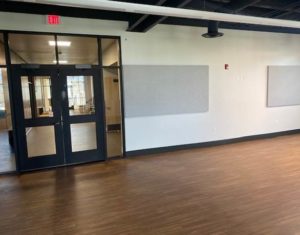
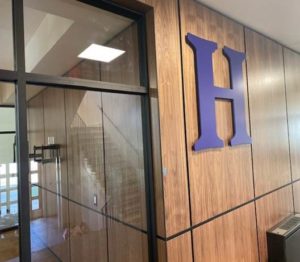
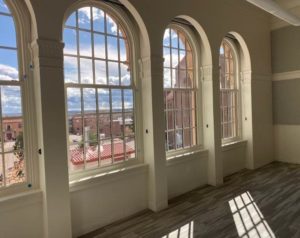
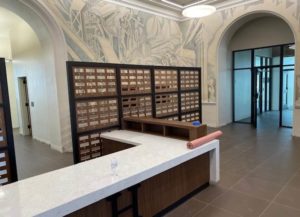
5. In an interesting twist regarding the free tuition proposal—some NM students are apparently questioning the idea altogether if it is funded by the extraction industry and the associated environmental problems in that industry. Some students have vowed to make their voices heard by going on strike and or marching on the State Capitol. One student asserted, ““It really is a double-edged blade. New Mexico has never had the best education system. We’re always bouncing between 49 and 50th. It is really important that we give everybody access to a good education. However, what we’re doing now is that education comes at a cost.” From the perspectives of these students, the “cost” is environmental degradation. We’ll see where this lands, but I have to say, the position these student have taken warms my heart. Even when they would directly benefit from free tuition, they question the wisdom of moving forward if it comes with an environmental cost. As has been the case throughout time, young people will show the way. For more, go to: https://www.krqe.com/news/education/new-mexico-students-conflicted-by-new-free-tuition-program-and-environmental-impact/.
6. The New Mexico Lottery Scholarship began over twenty years ago and was heralded as one of the most innovative and forward thinking scholarship programs in the nation. The program continues today, but transfers to the program have decreased over time. At present, eligible students must be residents of New Mexico and complete high school at a public or accredited private New Mexico high school. Students must enroll full-time at a public post-secondary educational institution in New Mexico within sixteen months of graduation. The “full-time” requirement is somewhat controversial since so many 2019 students, unlike students in the previous century, sometimes do not and often cannot attend full time. The initial scholarship begins with the second semester of enrollment at a college or university—that’s also one of the more controversial issues with the program. Students have to come up with a way to pay for the first semester. Thereafter, the scholarship is renewed on a per-semester basis. Students must remain consecutively enrolled each fall and spring semester (sometimes tough for students in 2019) to maintain eligibility for the scholarship. The scholarship may be renewed at a four-year institution until the award recipient has received seven (7) semesters of scholarship awards or until the student graduates with a bachelor’s degree, whichever is sooner. Another question…how may 2019 students graduate in four years? The New Mexico Lottery Authority recently provided an update to the Legislative Finance Committee about the program and I’ve attached their presentation (above). Take a look, if interested. I think most slides are pretty self-explanatory.
7. I walked over to the Ray Drew this week to see the Native American show now hung in the gallery. Wow. It is really great and I encourage you to take a look yourself. Our campus and really, Las Vegas generally is such a great place for art. We are lucky to live in a place where the aesthetic dimension of life is so valued and easily accessible. One of the pieces hung in the Ray Drew Gallery:

8. I’ve had several queries regarding the swimming pool. Is it open? Is it safe? We recently had an independent analysis of the pool chemistry and…yes, it is open…and yes, it is safe. Another independent evaluation was done this week. Again, all OK. If you have concerns about the pool, please contact Dr. Kim Blea who has responsibility for that facility. Obviously, the safety of all who use the pool (i.e., students, staff, faculty, members of the community) is the #1 concern.
9. Many thanks to everyone who attended the HLC Forum on Monday afternoon. A nice crowd turned out for the meeting. That was the last forum of the term, but we’ll have one or two more right before the HLC visit in the spring. The unambiguous Dr. Allard holding forth at the forum (plural, I say—-fora):
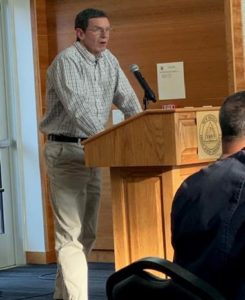
10.Last weekend VP Max Baca competed in and completed the Laughlin Spartan Race. These are heavy duty athletic events and completing even one of them is a great accomplishment. Max has now completed two of them. As I understand it, every time you complete one of these event you receive a portion of large medallion and when you complete enough of them (I think three), the medallion is complete. Eight miles and twenty nine obstacles later, Max is still smiling (through the pain). Max is guided by the Spartan Creed, but has modified it a bit: “This is my budget. I bear it before me into battle, but it is not mine alone. It protects all HU colleagues. It protects the university. I will never let my colleagues out of its shadow, nor my university out of its shelter. I will die with my budget before me.” Well stated by our resident Leonidas.

11.Congratulations to the Cowgirls and Cowboys on the victories Monday evening over Northern New Mexico. Both teams play an up-tempo brand of basketball—a lot of fun to watch. A very nice crowd was in attendance. The Cowboys are now 4-0. Coach Dominguez drawing up a play:
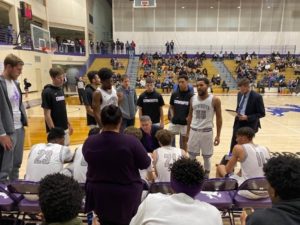
12.In preparation for several holiday events, four HU student groups visited the University Residence on Thursday evening to decorate trees, eat dangerous quantities of pizza, and swig many cans and bottles of soft drinks. It was a festive event and the trees….well….they are incredible. Many thanks to Dr. Blea for organizing the event, the students for their time and putting so much thought into the decorations, and the faculty and staff sponsors for their support. The finished trees and lower right, a Holiday Angel (not you, Leon).
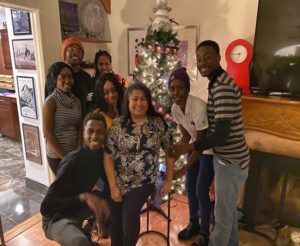
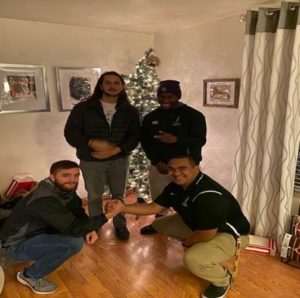
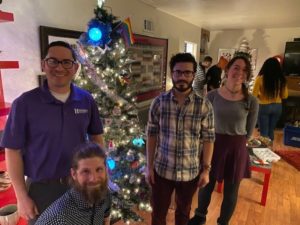
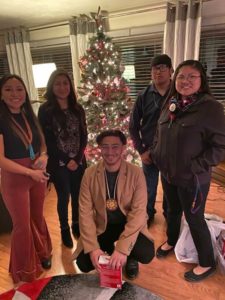

Sam Minner,
President
11.15.19
Greetings friends of HU. A brief update for the week
At the BoR’s meeting last week, Dean Sheree Jederberg briefed the board and those in the audience on the latest accreditation visit regarding our School of Education. As I was walking out of the room after the board meeting, two community members congratulated HU on a successful visit, but also asserted that K-12 performance in Las Vegas and America generally used to be much better than it is today. Both individuals were teachers many years ago and I bet they were both excellent, but I’ve often heard it said that nostalgia is not a good historian. I decided to check their claim out—were schools better in the past? I wasn’t sure, but from my perspective, they seem to have improved. Not that long ago, students of color were not allowed in schools at all and later were segregated with many relegated to inferior facilities, materials, etc. Not that many years ago, most disabled students were not permitted to attend public schools at all and those who did attend often spent days doing arts and crafts. That has changed. I dug around a little bit and I found this: https://www.washingtonpost.com/education/2019/11/05/were-public-schools-better-way-back-when-giving-todays-schools-an-honest-grade/. Here’s an infographic from that article. Clearly at least some things in the K-12 system have improved so in this case, perhaps nostalgia is truly not a good historian. But also clearly, more work to do.
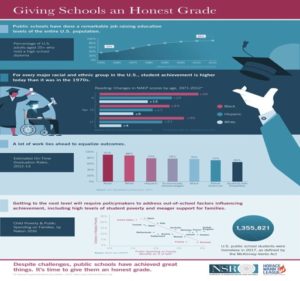
2. Kudos to Mike Petronis on his most recent publication. It is a highly specialized bit of research, but here’s a prepublication copy if you care to peruse: https://agupubs.onlinelibrary.wiley.com/doi/abs/10.1029/2019GC008477.
3. Many thanks to everyone who helped organize our activities for Veteran’s Day. I hear the term servant leader a lot, but I don’t think there is any better example of true servant leaders than the men and women who served or are serving the nation. Our thanks to them. Freedom is truly the most precious commodity in the nation and protecting freedom always comes with a price. Sometimes that price is being away from home, one’s family, etc. Sometimes the price is much higher than that. One of my favorite quotes about freedom…from the great American poet and philosopher, Ralph Waldo Emerson, “For what avail the plough or sail, or land or life, if freedom fail?” Special thanks are due to the Student Veterans of America Chapter here at NMHU and particularly Roy and Shelley Burton. A photo of our keynote speaker, Army Major John Vanderhee:
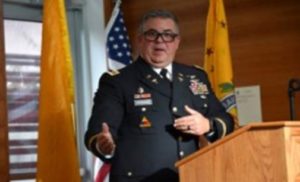
4. I had an interesting discussion with one of our students this week. She was listening to something that sounded like a lecture…and it was. She had recorded the lecture (I told her I wouldn’t reveal her name—she was a little nervous about taking with me) and admitted that a friend had recorded the class. She said she rarely attended the class since all that happened there was “a lecture” and the professor did not often take attendance. Her comment to me, “If it is just talk, I can record that and listen at any time.” Hmmmmm. I provided her with what I thought were some good reasons to attend even it is was “only a lecture”, but believe me, no minds were changed. I recalled my own early faculty days (literally in another century and before cell phones). I was the President of the Faculty Senate at the time and small and easily concealable recorders were common. My faculty colleagues proposed a policy that prohibited students from recording classes and as I recall, that sailed through without much discussion. The arguments put forward, as I recall them—students will somehow miss out (on something, but kind of not very specific on what) if they are not actually in class, lectures (and most everyone only lectured back then—I did) were forms of intellectual property and could not be recorded without permission, and my favorite—if students can record classes and not show up, why hold classes? Again…hmmmm. As I do every morning, on Wednesday I read Inside Higher Ed and sure enough, there was an article about this kind of thing. Here it is: https://www.insidehighered.com/blogs/confessions-community-college-dean/device-etiquette. If you don’t care to read the entire article, this quote provides a good overview (I highlighted the yellow sentence):
“Now, it’s easy for students to record classes without anyone knowing and to distribute those recordings to the world in seconds. That makes the old prohibitions much harder to enforce and raises the possibility of brief snippets being taken out of context to make someone look terrible. I used to teach political philosophy, so I can only imagine what could have happened if someone had posted, say, 10 key seconds of explaining Marxism. (“Pinko Prof Says ‘Smash State’ at State U, Still Cashes Paycheck”) Someone with an agenda could do tremendous damage to someone else just for doing their job. Still, I’d be lying if I didn’t admit that people bring devices into work meetings all the time. Sometimes they’re for note taking or looking things up, but most folks multitask to one degree or another. The sort of purity that some professors try to recreate with mandatory Faraday cages doesn’t even exist in many professional workplaces anymore. If anything, I’d argue that device etiquette is becoming a new workplace skill. Part of the historic role of higher education was to impart the cultural norms of the professional class. That may sound — and be — sort of creepy, but it’s part of enabling upward mobility. The catch is that those norms are evolving, especially where device etiquette is concerned. People acting in the best of faith, trying to recreate the classroom of 1995, aren’t preparing their students for the world they’ll encounter.”
I kind of regret to say, that in my case, I could truthfully alter this a bit and write, “…trying to recreate the classroom of 1985.” That’s sad—and a long time ago—but true.
5. I attended a Council of University Presidents (CUP) meeting this week. All the four year presidents were there and others also attended (e.g., David Abbey, Director of the LFC, Sandy Liggett, HED General Counsel, and several individuals from New Mexico EPSCor). The presidents reviewed our priorities for the upcoming legislative session. These are:
a. new money in the funding formula to (1) improve student services and advising, (2) increase enrollments, (3) improve retention and graduation rates, and (4) develop new programs
b. additional funding for compensation increases while modifying the process previously used to improve salaries (the previous approach required institutions to find the resources to fund about half of the raises)
c. additional funding for dual credit programs
d. additional funding to address deferred maintenance and improve technology, and
e. expansion of early childhood and other teacher education programs
There was also a discussion of the governor’s “free college” program (I think one of the best overviews of the free college debate can be found here: https://www.freecollegenow.org/briefing_book) and some projections about the future revenue New Mexico is likely to accrue from extraction (gas and oil). It does look like there will be additional revenue for the state this year, largely thanks to extraction, and that is good. However, there were also some warnings at the meeting that we could be looking at yet another downturn in oil production (go to https://www.marketwatch.com/story/producers-are-putting-the-brakes-on-the-shale-boom-heres-what-that-means-for-oil-prices-2019-11-01). As long as New Mexico is so reliant on extraction and government jobs, the wild ups and downs here will not abate. There may be very large investments in areas such as early childhood education, public safety, and a few other areas and that might dramatically reduce whatever new money is available for other purposes (like higher education). It also appears that the initial investments made as a result of the Yazzie case might not be deemed sufficient and if so, that could take some new money off the table as well.
6. Speaking of putting more money into teacher preparation, I spoke to one of our recent teacher education graduates this week who was admitted into our program, finished it on time, easily secured a job in the region, taught the 18-19 school year, and then….left teaching after one year to work for a car rental firm. All that work. All that preparation. All the efforts of faculty members. And…one year of service. I asked her about that and she was surprisingly willing to talk to me. She spoke to me at some length before she mentioned salary—the reason so many people think teachers leave so soon. It was all about the lack of respect she felt. Micro-managing by others. Extremely long hours. And, (not her word) but an almost total lack of agency in her daily work. She felt she had virtually no latitude or ability to make professional decisions about her work. I guess all this is generally known. I found this online: (https://www.forbes.com/sites/phyllislockett/2019/11/11/to-curb-the-teacher-shortage-we-need-to-think-bigger-about-the-problem/#49ce44614f2a). Here’s a quote from that article:
Recent statistics from the Learning Policy Institute list poor job satisfaction as the number one reason teachers provide for leaving the profession—ahead of personal reasons, desire to pursue another career and the often-cited compensation issues. Salary, of course, is a major component of job satisfaction, but if we’re going to revitalize American education and avoid a full-blown teacher crisis, we will need to think bigger about the problem. In the traditional classroom model, educators…are not supported to do what they set out to do, or treated like the leaders they can be.
This got me to thinking. We tend to focus on improving teacher education programs by improving curricula, providing more and better in-school experiences, providing preservice teachers with more financial support, etc., but…do we and can we do anything about what are apparently the real problems in teacher retention?
7. Online Schools Report recently named one of our programs as one of the best online programs in education. Here’s the story: https://www.prnewswire.com/news-releases/online-schools-report-publishes-ranking-of-best-online-masters-degrees-in-special-education-for-2020-300954731.html
8. The Georgetown University Center on Education and Workforce recently published their first attempt to measure Return On Investment (ROI) for virtually every institution in the United States. Their report was issued this week. For HU, the 10 year ROI is $73,000. The 15 year ROI is $216,000, the 20 year ROI is $346,000, the 30 year ROI is $570,000 and the 40 year ROI (considered a full lifetime of work) is $753,000. In other words, the forty year return on investment from attending and graduating from HU is about $3/4 million. For comparative purposes, I checked the ROI for students graduating from some of our in-state peers. At Eastern the 40 year ROI is $630,000 and it is $640,000 for students graduating from Western. Just for fun, I checked the 40 year ROI from an elite school—I just randomly selected Princeton. Their 40 year old ROI is $1,642,000. This is all very good news. Graduating from a college or university was and is a great investment and our performance looks good for institutions in our sector.
9. 4/5, 2/3, 42%, 40%, 59%, 44%, 27%, 23%, and 20%. Check out these statistics from the Lumina Foundation (shared with me at the CUP meeting):
Four out of five jobs lost during the recession were those requiring high school education or less. Those low-skill jobs are gone for good, replaced by jobs that require specialized training and skills.
Despite a lingering high unemployment rate, employers say that they lack qualified job applicants. By 2020,two thirds of all jobs will require postsecondary education. Young adults are continuing to enter the labor force ill prepared. At a mere 42%, the United States currently ranks thirteenth among developed countries in college attainment rates for young adults. The postsecondary attainment rate for adults is 40 percent. But the facts about attainment are far more complex. Adults who identify as Asian are leading in attainment with 59 percent, while whites come in at 44 percent. African American attainment rates are as low as 27 percent. Native American and Latino Americans complete postsecondary programs at even lower rates, 23 percent and 20 percent, respectively.
10. These last couple weeks have been good for HU. We’ve had previews that our specialty accreditations are on track in forestry (thank you Dr. Sloan and team) and education (thank you Dean Jederberg and team), word of some high level scholarship (thank you Dr. Petronis) the publication of a book along with a well-attended on-campus presentation (thank you Dr. Chadborn and also thanks to Dean Kempner and Ms. Kent for co-sponsoring the event), and the announcement that the HU School of Business Administration Ethics Team won the state ethics competition besting numerous schools including UNM (thanks to all of the students, Dr. Melanie Zollner—so nice to address her as Dr.—and Professor Carla Romero). These accomplishments are achieved by the hard work and dedication of our students, our staff, and our faculty. It is a privilege to be even a small part of all that. A photo of Dr. Chadborn’s talk (left) and the HU Ethics Team in action (right):
 .
. 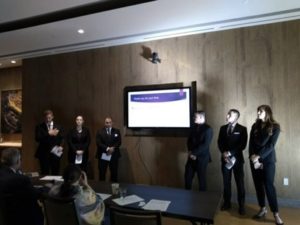
Greetings colleagues. A brief update for November 4-10—a little late due to several days in meetings in Santa Fe and an all-day board meeting on Friday:
1. There’s been some interesting discussions around the state about PED’s recent announcement that requires juniors in New Mexico high schools to take the SAT. The state of New Mexico will pick up the tab for this to the tune of about $1.2mil (https://www.abqjournal.com/1380296/ped-announces-sat-as-new-mexicos-official-high-school-assessment.html). Of course, a number of open admissions schools (like HU) do not require that test at all and many other schools around the country, including top schools like St. John’s, Smith College, Bowdoin, and many more do not require that or any national measure including the ACT. Of course, one of the long-standing criticisms of the SAT (and the ACT) is that it really measures socioeconomic status (i.e., the educational level of parents and the income in the household). I’ve heard many researchers assert….want to know the income level of the household a student was raised in?….give the student the SAT. Then you’ll know. I don’t think that is quite fair, but there is some truth to it. So…what does it mean to require the SAT in a poor state? Interesting question.
2. Many thanks to everyone who attended the Coffee with the President meeting last Monday. That entire meeting was devoted to the recent cyber-attack. Joe Gieri provided an overview of what happened, what we did, and the path forward. He really did a great job. Once again, a big thank you to everyone who pulled together on this…a great show of support for the institution.
3. The Rodgers renovation is proceeding and it looks great. I simply cannot thank Sylvia Baca enough for using the relatively small sum we had to produce what will be another shining star on our campus. As I think everyone knows, the building will be multi-use and include a modern classroom, a board room available for large meetings including community meetings (no more spending countless hours setting Kennedy up for board meetings…hooray), the HU Heritage Room, and some offices. The days of a bright line between “academic buildings” and “other buildings” are over and frankly on many American campuses, have been over for many years. Everyone will be moved by the end of the term. Here’s a photo of the second floor reception area. The design is meant to evoke an academic library with card catalogs. Most people know that Rodgers once served as the campus library. Really beautiful, no?

4. Joan and I welcomed a nice group of HU faculty, staff, and students to the University Residence on Tuesday to hear the slam poet Joaquin Zihuatanejo. Mr. Zihuatanejo is the winner of the individual Poetry Slam and the World Cup of Poetry. I don’t think I’ve ever heard a slam poet before, but I must say….Joaquin’s performance was incredible. Really great. Many thanks to Lauren Fath, her students, and others for bringing Joaquin to HU. A You Tube video of the poet performing quite a personal poem ( https://www.youtube.com/watch?v=KcmjgvUO9u8) and a photo of the group listening to our guest:
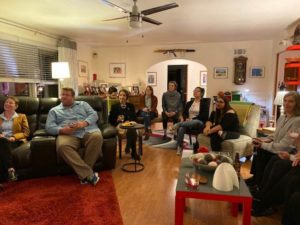
5. Last weekend was a great one for HU student athletes. The football team beat Western Colorado 24-22. The men’s basketball team beat Eastern New Mexico in an even closer game (112-108 in overtime) and the Beloved Vatos won again beating Regis University 50-20. The Cowboys in action:
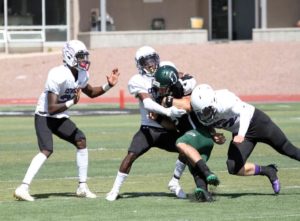
6. The New Mexico Highlands Board of Regents had a productive meeting Friday and participated in a lengthy discussion focusing on the golf course. There’s a range of opinion both in the Highlands community and the Las Vegas community on how to proceed with the course in a fiscally responsible manner. That range of opinion was expressed in the Regents’ 3-2 vote against proceeding with the Golf Course Management Task Force recommendations of approaching potential partners for financial assistance to operate the course through the spring, authorizing the issuance of an RFP not to exceed $190,000 to hire a consultant, committing to the formation of a development corporation to develop the course and other university properties, establishing a $100,000 seed account to fund the development, planning, and start-up costs, and for the formation of an implementation group to coordinate and manage the project. While the majority of the Regents voted against the proposal, we will continue discussions on what to do with the course in line with our fiduciary responsibilities. The goals remain the same—retain the golf course, improve it if possible, but live within our means. On the academic side, the regents approved a new distance degree, a Master of Arts in Cultural Resource Management. I’m excited faculty members are working on new degree programs like this that will attract more students and applaud Dr. Orit Tamir’s work in creating this program. We still need to have it approved by the state Higher Education Department and the Higher Learning Commission. If all goes well, it could be offered next fall. Dr. Lauren Fath, this year’s Presidential Fellow, presented several ideas her committee suggested to increase our summer enrollment. The committee recommended taking a look at our dual-credit program to see if we can increase summer enrollments through such offerings, creating a Cowboy Boot Camp program that would help incoming students who are statistically at risk for not finishing a college degree, and the creation of low-residency program where students would take online classes through the year and meet on campus for classes during the summer. The regents also approved a proposal put forward by Dr. Denise Montoya, our director of HR, to move forward on a compensation study. New Mexico Highlands, like other institutions in our state, is facing a challenge in attracting highly qualified employees because of the salaries we are offering. Like many of our efforts, there will be a range of ideas and opinions on how we move forward on this study, but I know we will engage in a productive dialog on this matter. Interim Dean of the School of Education, Dr. Sheree Jederberg, gave the board an overview on the progress of the SOE’s accreditation from the Council for Accreditation of Educator Preparation (CAEP), the national organization accrediting professional education programs. While we are awaiting the final notice, our application looks very promising. Well done to the School of Education faculty, Provost Gonzales, and Dean Jederberg. The efforts of retired Dean Virginia Padilla Vigil were also instrumental in this process. In other actions, the Regents approved our quarterly financial reports and approved the disposition of surplus university property. The board also met with me to do my annual performance review. I have had more annual reviews, 360 reviews, and other performance evaluations than I care to admit, but…the reviews I have had here at HU are clearly among the most thorough. I have previously had “reviews” (if you want to call them that) where my boss handed me a review form and asked me to fill it out. As you might imagine, I put as much work into that process as my boss did, but in the end, I did quite well on them. It was kind of ridiculous really. But, that’s not the case here at HU and I appreciate that very much. Every day, I feel privileged to work with such an amazing group of board members, faculty, staff and students.
As I left that approximately seven hour meeting I reflected on what had gone on there. In the case of the golf course, people with strong emotions on both sides listened to each other, respected each other, and adhered to a process resulting in an ultimate outcome. Some approved of the outcome. Some didn’t. But, it was a case study of how reasonable and engaged people interact with each other. Kudos to all of them. The meeting finally ended and as I drove home, I thought of another old saying I’ve heard many times, “Those who criticize the integrity of others reveal what they lack.” True. True. All in all, not a bad day—lots of business was done and now onward.
1. A very nice article in a recent Albuquerque Journal focusing on the John T. Harrington Forestry Research Center where HU scientists collaborate on projects with scientists from New Mexico State and other agencies. Here’s the article: https://www.abqjournal.com/1383687/helping-to-bring-a-forest-back-to-life.html.
2. Very unfortunately, cyber-attacks continue here in New Mexico. Go to: https://www.lcsun-news.com/story/news/education/lcps/2019/10/29/ransomware-hits-las-cruces-school-servers-prompts-shutdown/2498837001/?cid=facebook_Las_Cruces_Sun-News.
3. Many thanks to the faculty and staff who attended the HLC Forum on Monday afternoon. That forum focused on enrollment management—the HLC team will examine what we’ve accomplished in regard to enrollment and retention processes and practices since their last visit. Please keep in mind that the team wants to see a plan and then some data about how that plan is working out…and what if anything we are changing based upon our review of the data. Those are the relevant standards. One key thing we’ve done in recent years is engineer the Division of Strategic Enrollment Management and acquire new tools to improve our enrollment systems. One major tool recommended to us from our former engagement with Ruffalo Noel Levitz was the Customer Relations Management tool, Slate. Ms. Jessica Hurtado provided a very nice overview of what this product does and how we use it. In the event you were not able to attend the forum, that presentation is attached here: G. Glover Artifact Visit 10.28.19.
4. Stories about college teams staying in out of town hotels and causing lots and lots of problems are legion. I’ve dealt with too many of them over the years. But…sometimes, coaches receive feedback like this sent from the manager of an out of town hotel where our football team recently stayed (manager’s name and name of hotel deleted):
Hi Martin,
My name is XXXXXXXX and I am the front office manager of XXXXXXXX in XXXXXXXXX. I had the pleasure of meeting your team and did their breakfast service this morning before their departure. I just wanted to take a moment to commend you. I have been in this business for well over 10 years and I was very impressed by your team. I have had several bad encounters with large groups, specifically boys in this age range. I am thoroughly impressed by the mannerism and the respect your team showed toward myself and my staff. They were polite and courteous, and I did not have a single complaint from housekeeping about the rooms they occupied. Kudos to you and your staff for making this a pleasant experience for us. We really hope you enjoyed your stay with us and will consider us in the future. I cannot thank you enough for their behavior, you have an outstanding team, that you should be very proud of.
5. Dr. Mike Petronis and one of his former students recently published a paper in the journal Volcanica. The complete paper is attached here: The leaning Puy de Dôme (Auvergne France) tilted by shallow intrusions. Well done to all authors…a great example of high impact teaching and learning in practice. Thank you Mike for doing more than you have to do in order to powerfully engage students in learning.
6. On Tuesday, the Provost and I traveled to Rio Rancho to hear the summary report from the team leader from the Council for Accreditation of Educator Preparation (CAEP)—the national organization accrediting professional education programs. The team leader will be sending the full report to the CAEP national offices in Washington, D.C. Nothing is real until we receive the final report sometime next March, but…..it was an extremely positive report. A few quotes from the summary report (it was a public meeting so I am not breaking any confidentiality):
“The School of Education at HU is small but mighty”
“It is all about continuous improvement and the HU School of Education lives that”
“ You have a great pass rate on the state exam”
“Your students say they are well prepared for the diversity they will see in their classrooms”
“Your students were so complimentary of individual faculty in the School of Education and the team spirit they observed among the entire faculty”
“Your relationship with other constituents—schools, PED, others—is great” (I should note that a representative from PED was present during the entire accreditation visit and I really appreciated that).
“Your students love you. The K-12 community loves you.”
In the end, the reviewers stated that they found no Stipulations (“Stipulations” is the term used by CAEP to note major problems potentially leading to probation, an accelerated program review, or even loss of accreditation). As anticipated, there were some suggestions for improvement—but really quite minor things.
This is a little premature—as I wrote, we won’t receive the final report until next March—but well done, well done, well done to the School of Education faculty, Provost Gonzales, and Dean Jederberg. The efforts of retired Dean Virginia Padilla Vigil should also be recognized. Thanks you so much Virginia. CAEP accreditation is not easy to acquire unlike the old NCATE days when nearly every school received a positive accreditation recommendation and maybe (at most) a little slap on the wrist. I mean…you really had to miss the mark completely to have accreditation problems from NCATE (…and I should know…I was an NCATE examiner for many years—numerous accreditation visits— and have struggled through dozens of rubber chicken dinners to prove it). It is a different deal today. CAEP’s objective and clear eyed affirmation of what we are doing, the quality of our programs, the commitment of our faculty, the team spirit the CAEP examiners observed, and the resolve and skills of our leadership, particularly former and current decanal leadership, is very encouraging and affirming. I know we and other schools of education across the state and nation face many challenges—mainly, convincing more people to become teachers, school administrators, etc. (go to: https://fee.org/articles/the-teacher-shortage-is-real-and-about-to-get-much-worse-heres-why/)—but our program has been measured against high national standards and…we met those standards. Again, well done to everyone who made this happen. One way to demonstrate strong programs and improving program reputation is to apply for specialty accreditation even when a given program is not absolutely required to do so. For that reason, among others, I strongly encourage programs with an option to apply to specialty accreditation to apply. We have a good record in that area recently—business had a successful accreditation visit. Just this week, several colleagues from our forestry program attended the hearing for accreditation in that program. The accreditation team complimented and congratulated the faculty and HU. We’ll formally hear about the status of that one soon. But, things look really good. Now education. We are more than capable of achieving the national standards of our specialty accreditors and indeed, we can exceed them.
7. There’s been several interesting developments this week in regard to the Yazzie/Martinez v. State of New Mexico case. Basically, attorneys for Yazzie/Martinez assert that the funding approved last year is still simply too low to address the needs of students and does not meet the provisions and requirements of the lawsuit. Here’s an article about what’s going on (https://www.kunm.org/post/yazzie-attorney-education-funding-still-too-scarce) and here’s a video of a hearing focused on the situation : https://www.facebook.com/KUNMRadio/videos/705528176613482/.
8. Our beloved Vatos participated in the High Desert Classic last weekend and swept the competition. They defeated NM Tech, UNM, and the Air Force Academy. Well done Vatos! Their trophy from the tournament:
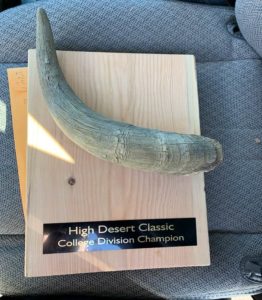
9. Our neighboring institution, the United World College, is looking for local families to participate in its intercultural exchange program called Get-Away Family. Being a get-away family for a student or two is such a rewarding experience by spending time with the UWC students, including them in some of your family’s activities like preparing a home-cooked meal, taking in a film or concert, or providing a short stay over the holidays. Participating families are invited to many of the UWC campus activities as well. UWC students come from all parts of the world and spend their junior and senior year of high school here in northern New Mexico. Learn more and fill out an application at: www.uwc-usa.org/our-coummunity/get-away-families .
10. Inside Higher Education released a report this week focusing on faculty members’ perceptions of online learning. Some key findings:
· Nearly four in 10 instructors (39 percent) say they fully support the increased use of educational technologies, up from 32 percent in 2018 and 29 percent in 2017.
· Neither faculty members nor digital learning administrators believe online learning is less expensive to offer than its on-ground alternative — unless colleges reduce spending on instruction or student support.
· Majorities of professors and digital learning leaders alike generally oppose colleges’ use of external vendors to deliver online academic programs, except for marketing to students.
· Professors believe textbooks are too expensive and support use of open educational resources as an alternative.
· Six in 10 faculty members believe academic fraud is more common in online courses than in face-to-face courses, while the rest believe fraud occurs equally in both.
You can download the entire report here: https://www.insidehighered.com/news/survey/faculty-support-online-learning-builds-slowly-steadily-not-enthusiastically.
11. It didn’t take the NCAA long to reverse their stand on allowing student athletes to financially benefit from their names and images (on t-shirts, caps, etc.). Here’s the press release from the NCAA : http://www.ncaa.org/about/resources/media-center/news/board-governors-starts-process-enhance-name-image-and-likeness-opportunities. A quote from that press release in if you want a quick overview, “In the Association’s continuing efforts to support college athletes, the NCAA’s top governing board voted unanimously to permit students participating in athletics the opportunity to benefit from the use of their name, image and likeness in a manner consistent with the collegiate model. The Board of Governors’ action directs each of the NCAA’s three divisions to immediately consider updates to relevant bylaws and policies for the 21st century.”
October’s Americana radio show is done. Go to: https://www.dropbox.com/s/1bqqeczpn8qz7q3/big-sam-show-3.mp3?dl=0 The November edition will be posted soon.
For some strange reason, I’ve heard two people in two different settings say this very thing this very week, “Process is the killer of innovation.” I guess that is going around. I wonder if it is true.
Sam Minner,
President
Greetings colleagues. A brief update for the week October 21-25:
1. It feels like we are approaching something close to normalcy on the campus after the cyber-attack—a day many students apparently now refer to as Cyber Wednesday. Classes were in session this week and most of our business functions were operational. And most HU colleagues had some machine on their desk or at least access to a computer that worked—at least a bit. At one time, I had my desktop in front of me (did not work) and three laptops with limited functionality on each one. Arrgh. If there is any silver lining in all this—and I am reaching here—I observed at least some additional face to face interaction (i.e., talking to each other) when we all had less access to technology. That seems like a good thing to me, but I don’t know…maybe that is just a longing for the days when technology was not so common. They say nostalgia is not a good historian and maybe…things really weren’t so great back then after all. I do recall studying the sociologist Charles Cooley who warned people that the morning paper would significantly cut down on the social interactions in families. Did that really happen? Maybe. The same warnings were issued when TVs appeared in most American homes. Then video games. Then cell phones. On and on. Bottom line for me….glued to technology is a choice. Thinking that you can’t work or get anything done without technology is mostly not true. Obviously if you are teaching on Zoom and Zoom is not working, you have a problem. But still…unable to work at all…unable to get anything done? Not sure I agree with that. In 1950, people did not have to read the morning paper at breakfast and ignore their kids or other human beings. That was a choice. Texting or checking message at a restaurant while your kids sit trying to get your attention is a choice (as I observed at a fast food restaurant the other day)—and I see that so often these days. Having the phone permanently affixed to your ear—at work or wherever—is a also a choice. Let us choose wisely—advice I absolutely do not always take myself.
2. Max, Joe Gieri, and I were in Santa Fe this week to brief HED on the cyber incident. HU was credited with handling the attack well and there was also an interest by HED officials to share the lessons we learned with other institutions in the state.
3. On Wednesday I attended an HU Foundation Budget and Finance Committee meeting. One of the most important metrics in any fundraising operation is the “cost of raising a dollar” statistic. A few years ago, we spent more than a dollar to raise a dollar—in other words, we were losing money and not exactly a recipe to accrue additional resources. Our most recent performance revealed that we spent .35 to raise a dollar. We’d still like to improve that, but what a change. Well done Advancement team.
4. Speaking of Cyber Wednesday, it highlighted the almost constant tension I feel to encourage my colleagues and instill confidence moving forward and remaining grounded in the very real challenges we face every day. I’ve worked for leaders who never—-and I mean never—said anything negative about the organization even when things were going south. That almost always seemed insincere and just not in touch with reality. It doesn’t’ instill confidence. I once worked at a university placed on probation by the regional accreditor (not HU). The president at the time who had one year left on her contract (an important detail) asserted it was not a big deal, the school could move on without accreditation, and it was just not something to worry about. No one believed her, mainly because…it just wasn’t true. Then again, I’ve worked at schools where presidents gave the annual state of the university speech and did nothing more than list all the problems we faced and dire predictions about the future. One president even recommended that faculty renew their Chronicle of Higher Ed subscription since many of them would soon be on the job market. Wow. That was really an upbeat start to the new academic year. For me, the lens I use is…how do I really and truly feel about the future? I reflect on that. And then, I tend to use that to set the tone. Every organization faces threats and problems, but all have at least some assets as well. I carefully observed the behavior of a president (and I think a very good leader) who faced a campus closure. It was a private school and it just ran out of money and students. The guy was totally frank and up-front about the whole thing, but also did everything he could think of to help students and employees transition to something else while celebrating the many achievements of the institution over time. He was present all over the place…no hiding behind slick public relations campaigns. No blame game stuff that former presidents or others should be blamed. In my view, he handled it all with high integrity and I would even say grace. It certainly was not good news he had to tell, but even under those circumstances, he focused to the degree he could on the future of the people there—students and employees. It was a classic example of servant leadership in action. Lesson learned from my perspective…be direct, be honest, listen carefully to others, and yet….move forward as best you can and, if possible, attempt to instill confidence that things could improve over time. In my view, most people tried to follow that prescription after our cyber-attack and I thank them for it. It wasn’t a good thing, no doubt, but it was also true that the sky was not falling. Here’s an article I read recently about this kind of thing: https://www.insidehighered.com/blogs/call-action-marketing-and-communications-higher-education/perils-pollyanna.
5. Congratulations to Coach Fine, our assistant coaches, and all of our football student athletes on their victory last Saturday. The Cowboys defeated Black Hills State 17-13 in a home game at Sanchez Stadium. A photo of the Cowboys in action:
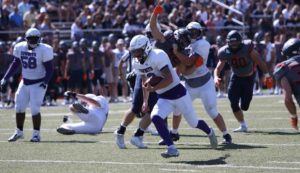
6. We have recently been quite active in the grants domain. This Friday, we submitted a proposal to the state to fund an outdoor activity business incubator. If funded, we’ll establish a structure to assist new entrepreneurs to establish and operate new outdoor focused businesses catering to tourists and local citizens. Think things like nature walks, fly fishing excursions, photography trips, bike trips etc. It would really be great to capitalize more powerfully on the many outdoor and recreational assets we have in the region. We are also preparing for a visit from a private foundation, the Sherman Fairchild Foundation, interested in providing funds for scientific equipment. We were asked to apply for this grant so there is clearly high interest from the funding source. Finally, we are also preparing a TRIO proposal. We absolutely should have one of those projects at HU. Let us hope on that one. Grants can be very helpful, but people with limited or no experience in this domain too frequently offer that up as a solution to a problem. (Heh…we need this program. Let’s write a grant!). If it were only that easy. In a former job, one of my duties was to assist other faculty members (if they wanted to be assisted) in writing winning grants. As you might expect, most of my colleagues who wanted to be assisted were new to the academy—new and untenured assistant professors. I found that this work was really difficult. Quite a few new professors simply had no formal or even informal training in the grants domain and were starting from ground zero. The most common issues I had with these colleagues—(1) they had some idea what they wanted to pursue and then tried to force fit their idea into some RFP they or we found, (2) their belief that writing the application and then implementing the project (if funded) was going to be much less complicated and time consuming than it actually was, and (3) nearly zero expertise with post award activities including budgeting. My take—if you win a large grant you immediately become an administrator, at least to some degree. I’m not sure if I would still find these things today, but back when…they were ubiquitous. I found a “rule of three” standard to be at work here. Colleagues merely observed what I did on the first application and then we talked about it, then they assisted in some meaningful way, and then I assisted them. As you can imagine, it took years to implement this particular rule of three. Very time consuming.
7. The New Mexico “free college” program continues to generate interest here in our state and beyond. One issue that continues to come up in the whole free college debate has to do with the purpose of going to college in the first place. If you start with the premise that going to college (free or otherwise) is or should mainly be about economic opportunity and adding to the number of people earning good incomes, then it might make sense to suggest that free college should perhaps be limited to students studying certain subjects. For example, a student capable of being a pharmacist (incomes often exceeding $100k), but lacking the financial ability to finish a pharm program, might be a great candidate for a free college program. That makes sense if the driver is jobs. Alternatively, someone interested in becoming a poet might not be a good bet for a free college program. However, if the purposes—the goals—of a college education transcend jobs, earnings, and the like…the situation might look different. If for example, one starts with the assumption that a college education is really a benefit to the nation as a whole—not just the individual— and that a healthy democracy requires educated people highly engaged their communities and living lives of meaning and purpose…well, free college would arguably be as important for the poet as it is for the pharmacist. It just depends on the thinking on the front end of things. Here’s an essay that touches on this issue: https://www.politico.com/agenda/story/2019/10/17/free-college-is-the-wrong-answer-001289.
8. Our own Angry Samoan, Gregg Turner, will teach a special course on the history of punk music in Santa Fe this coming spring term and Gregg and the class will be featured in an upcoming edition of Pasatiempo in the Santa Fe paper. As many of you know, Gregg was once a writer for the magazine CREEM and played with the Angry Samoans, an early LA punk rock band.

9. I have been asked to serve on a committee preparing a response to the California “pay to play” law that will go into effect in 2020. I agreed to serve. That issue is really heating up around the nation and here in New Mexico (go to: https://www.abqjournal.com/1373686/nm-to-consider-loosening-amateur-rules.html). Here’s what I thought was a well done article suggesting that the California law is a bad idea (https://www.baltimoresun.com/sns-tns-bc-studentathletes-pay-con-20191024-story.html). If you don’t care to read the entire article, this quote pretty much captures the author’s sentiments, “College athletics has been filled with millions of young men and women who have put thousands of hours into their craft with the goal of competing at the collegiate level and receiving a full scholarship to boot. These talented student-athletes will compete for four years, earn a degree, and go on to become a professional in something other than the sport they played. That is life for 99% of student-athletes. But those opportunities are at risk under the new law, which will become a slippery slope resulting in full professionalism.”
10. Three HU students recently each received a $1000 scholarship from the del Norte Chapter of MANA. The students appear in the photo below (from left, Ms. Jessica Benavidez, Ms. Ashley Grant, and Ms. Jennifer Hooper. Each is a great example of HU commitment, grit, and high achievement. Congratulations to each of them.
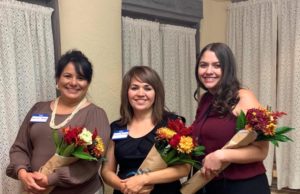
11. On Thursday evening a nice group of HU students, staff members, some kids, and others congregated at the University Residence for a pumpkin carving event. Many pumpkins were carved, pizza was consumed in large quantities, the Erudite Bella went a little nuts attempting to steal a slice of pizza from people, and one finger was slightly cut. All in all, a very successful event. A photo:

October’s Americana radio show is done. Go to: https://www.dropbox.com/s/1bqqeczpn8qz7q3/big-sam-show-3.mp3?dl=0
Sam Minner,
President
1. Thanks to the incredible efforts of so many HU employees and friends, we continue to make progress getting the campus fully up and running. I must say, the tireless dedication and commitment I’ve observed from so many people has been gratifying to say the least. American culture in 2019 is too often characterized by a focus on self over the greater good, mean spirited and personal attacks on others, and apparent disregard for the greater welfare. It feels like the exact opposite of my grandmother’s admonition to me, “If you can’t say anything good, don’t say nothing at all.” Grandma was no grammarian, but was one of the wisest people I’ve ever met. We all have our strengths and relative shortcomings, no? Today, sometimes it feels like the mantra is, “If you have something really mean to say or hurtful to say, fire away my friend! Anything goes!” But, clearly, that’s not the case here at HU. This week I had back to back meetings focusing on the cyberattack. Meeting #1 was really positive…the room was filled with people who had been at it for a while, but were still supremely optimistic and pulling together. I attend lots of meetings and to participate in one with that kind of vibe is rare. I had another one right after and….wonder of wonder…another positive one. Different people yet positive vibe. I am proud to call you my colleagues. Thank you HU colleagues.
2. HU’s Environmental Geology program continues to push hard on providing their students with great and in many cases life changing high impact learning opportunities. Recently, geology faculty and students attended the Geological Society of America’s annual meeting in Phoenix, Arizona where Ms. Sindy Lauricella presented her research on the dormant Kransy-Vrch volcano in the Czech Republic. She worked on her study during the summer of 2018. Dr. Mike Petronis accompanied several geology and other students on that excursion. Ms. Lauricella considers Dr. Lindline and Dr. Petronis to be her “role models” and much more. Well done to Ms. Lauricella and her role models….Jennifer and Mike. High impact instructional practices are transformational. A photo of Ms. Lauricella:

3. In recent HLC news, we’ve submitted the following dates for our comprehensive review (not the focused review we’ll have next spring). They are:
November 8, 2021
November 15, 2021
February 28, 2022
April 4, 2022
The HLC will let us know the final date they select sometime this November. The HU colleagues (awaiting final confirmation) who will be attending the annual HLC National Conference are Regent Bill Garcia, Dr. Roxanne Gonzales, Mr. Max Baca, Dr. Ian Williamson, Dr. Orit Tamir, Dr. Gloria Gadsen, Dr. Lauren Fath, and Dr. Lee Allard. In my view, this is a very nice and broad based group of colleagues—one of our regents, several administrators, and several faculty members. Colleagues, I understand that it is a substantial commitment to send these individuals to Chicago, but I feel it is a good investment. We simply must never take our collective eyes off our commitment to our accreditor and ultimately, to our students and beloved institution. Some time ago, the BoR required me to devise and submit a plan to do all possible in order to never have HLC issues again. One dimension of my plan was to be much more engaged with our accreditor and sending the contingent noted above is part of that plan.
4. There’s incredible buzz around the country and right here in NM about the so-called “Fair Play” bill recently signed into law in California. Many states are seeking to emulate that new law. There is some interest here in NM to allow student athletes to engage agents and profit from (if they can) their images, names, etc. Here’s a really nice overview of the situation, which I should note, is vehemently opposed by the NCAA: https://www.nytimes.com/2019/10/01/opinion/california-student-athletes-paid.html?auth=login-email&login=email. Dr. Jay Lee sent me a nice article expressing another view about all this (go to: https://www.thedrakegroup.org/2019/10/03/the-drake-group-is-encouraged-by-federal-and-state-initiatives-regarding-college-athlete-name-image-and-likeness-rights/?utm_source=rss&utm_medium=rss&utm_campaign=the-drake-group-is-encouraged-by-federal-and-state-initiatives-regarding-college-athlete-name-image-and-likeness-rights). A quote from that article if you don’t care to read the whole thing, “The inalienable right to profit off one’s own identity and body is grounded in constitutional law and basic civil rights. Thus, it is unfathomable that one group exists in America that is actually prohibited from doing what is allowed as a matter of course for all other American citizens.”
5. Many kudos to HU Cares, Dr. Kim Blea, and everyone who was a part of bringing a Six-County Substance Abuse Prevention Summit to the HU campus. The Summit will take place on October 24 in the Wilson Complex. More than 1,400 students are scheduled to attend. Funding for the Summit comes from the New Mexico Public Education Department and the New Mexico Health and Human Services Department. Recent studies revealed that New Mexico ranked second highest in the nation for cocaine and Ecstasy use, fifth highest for methamphetamine and eighth highest for heroin. The survey also found that one in four New Mexico high school students said they had used marijuana at least once in the 30 days prior to the survey. New Mexico ranked second among U.S. states by that measure. Hopefully, the Summit and many more initiatives will turn those numbers around. Our greatest asset—our youth—are literally at risk.
6. HU and other community partners hosted the 22nd Annual College Night this week and welcomed a large and engaged group of future Cowboys and Cowgirls. Many thanks to Jessica Hurtado and her team for making the event a success. A photo from the event:
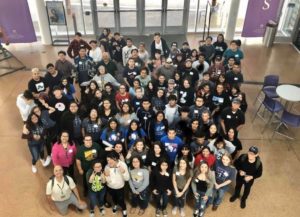
I want to also thank the HU departments and offices that went out of their way to help us recruit students at this event. They are:
· Admissions
· Office of Graduate Affairs
• Media Arts & Technology
• RN-BSN Program/Nursing Department
• Career Services
• Psychology
• Campus Life
• Business Administration
• Office of Financial Aid and Scholarships
• English
• Computer and Mathematical Sciences
• Thomas C. Donnelly Library
• Visual and Performing Art (Fine Art)
• School of Education
• Music Program
• Social Work
• SOE/Alternative Teacher Certification Program
• Curriculum and Instruction
• Biology
• Special Education and Educational Leadership
• History and Political Science
• Natural Resources Management
• ARMAS in Education
• Schools of Business
• Student Success Center
• Languages and Culture
• Esports
• HU CARES
Thank you so much. Your efforts have not gone unnoticed.
7. NMHU recently received funding from the Regional Development Corporation (RDC) to more powerfully prepare professionals in the hospitality industry in Northern New Mexico. There is room for 20 participants. Many thanks to the enigmatic Leon Bustos for working on this important initiative. Details appear in the poster below:

8. The so-called “churn” in higher education administrative posts is apparently getting worse with administrators now more than ever opting to return to the faculty ranks. Faculty members are remaining in the academy longer and longer. I know a few in their 70s and even some in their 80s. But, administrators come and go frequently…with increasingly shorter tenures. To wit, I’ve been in New Mexico slightly more than four years and I am second most senior president in the state. Wow. Second longest serving. I still really feel I just arrived. Top administrative jobs are really tough and can be hard on people’s relationships, their health, and more. But, top administrative jobs in colleges and universities remain highly prized and attract dozens if not hundreds of applicants. Why? Because those jobs are among the most rewarding way to make your way in the world. Helping people, especially students, do good and positive things in the world and helping people to achieve their dreams is no small thing. It is said that a full professorship with tenure is the “best” job in higher education. Maybe. I’ve said it. But, I still say my job is the best job in the academy and I have been a full professor with tenure multiple times. An endowed professor too. But still, in my view, this job is the best. I love my job and appreciate the opportunity to get up every day and serve HU as best I can. But, the increasingly shorter tenure in administrative postings trend continues with the average tenure of higher education administrators going down nearly every year. For example, in 2017 the average tenure for a university president was about seven years. In 2019, it is less than six and going down. A 2017 study by ACE found these issues are the most challenging for sitting presidents (the header says top five challenges but more than five appear on the list….a typo I guess). I was a respondent on this survey.

What about those who move out of administration into (or back into) the faculty ranks? How do they fare? I’ve had some experience with that. I’ve known many colleagues I consider great leaders who moved to the faculty and in so many cases, they became some of the strongest—the best— faculty members at the institution. They know and respect the faculty life and the faculty perspective, but they also understand the many complexities and challenges associated with leading and managing modern colleges and universities. These dual understandings often make for the most thoughtful and helpful faculty members around. Of course, it doesn’t always work that way. I’ve also known a few administrators who returned to the faculty and had many problems there. They weren’t satisfied or happy. One key difference seems to be why they left their administrative jobs. If they left administration of their own volition and desired more student contact, fewer budget and personnel issues, etc. they seemed mostly happy in the faculty ranks. If they had to leave—were not renewed in their administrative role for some reason—they were often not very happy at all. I’ve known both over my career. A former administrative colleague of mine contacted me a few days ago and we talked a bit about his return to the faculty—something he was struggling with a bit. His transition was not totally of his own choice. He was pretty certain there would be a change in the administrative job he was in and he had been thinking about moving to the faculty…so he did so before he perhaps had to do so. Now, he is struggling a bit. More than a bit. I’ve seen people go through those struggles quite often. There have been hundreds of articles written about making the move from faculty to administration, but relatively few focusing on the other direction (administration to faculty). Here’s one: https://chroniclevitae.com/news/2024-i-was-a-dean-and-now-i-m-not. I made a few notes about all this and hope to write a paper about it when I have some “down time” (sigh). I know that several of my HU colleagues have done that—moved from administration to (or back to) faculty. If you want to give me any reactions to how that worked (or not), please do so. I’d appreciate them. At this point, my plan in the paper is to focus on the strong identity some (but not all) administrators have with their job, their title, and the accoutrements that go along with that job. It is just human nature, I guess, but when someone has been a dean or a provost or whatever for a very long time, they come to see themselves and powerfully identify with that role and sometimes have difficulties when they no longer are in that role resulting in a loss of self-esteem and other problems. In some of these folks, I’ve also seen anger and occasionally, even depression. I could be wrong, but the “over-identification and confusion between self and role” idea is the tack I am taking at this point. One of my best mentors once told me after I had just been named the founding dean of a new school, to carefully examine my business card. It said Sam Minner, Ph.D. and on a second line, Dean of the School of Health Sciences and Education. He asked that I took special note that there were two lines on my card. I was a complete person (the first line) aside from the job title I had at the time (the second line). That was really good advice and he closed by saying I was heading for big trouble if I ever got the two mixed up. Again, great advice. Thank you former President Magruder.
October’s Americana radio show. Is done. Go to: https://www.dropbox.com/s/1bqqeczpn8qz7q3/big-sam-show-3.mp3?dl=0
Sam Minner,
President
Special message, Monday, October 14, 2019
Greetings colleagues,
The ITS Department has made great strides in countering last week’s cyberattack. These types of attacks happen across the country to any number of public and private enterprises. I know this sophisticated attack has been a disruption to our mission at an important part of the year, and I appreciate everyone’s patience and communal efforts in getting New Mexico Highlands fully operational.
Before I get into where we stand this morning, I enthusiastically applaud Highlands’ ITS team, which has been working around the clock since they discovered the attack. They still have many hours ahead of them, and each and every one of the IT team deserves our gratitude. I also know a number of faculty, staff, and students have volunteered to assist IT in containing the malware, and many people outside of ITS have been working extra hours to help mitigate the interruption of campus services. Those volunteers and dedicated employees have embodied the Highlands spirit of family. Thank you, thank you, thank you. I also thank the outside agencies who have lent their support and expertise.
This morning’s developments:
• ITS is still in the process of inoculating Highland PC’s on the NMHU network. The PCs that have been cleared for use have been tagged “scanned.” There are a number of PC’s that have been cleared for use however, there are some that have been disconnected from the network and need to be rebuilt.
If your Highlands computer has been disconnected from the network (for example the blue or yellow network cable is unplugged), your computer is infected by the malware attack. DO NOT PLUG YOUR INFECTED COMPUTER BACK INTO THE NETWORK OR CONNECT IT TO THE WIRELESS NETWORK! ITS is formulating a plan to rebuild infected computers and will reach out to your unit to schedule repairs.
• Timesheets are due. Please complete your electronic timesheet – they can be filled out online accessed by your home computer, cell phone, tablet or Highlands computer if it has been cleared by ITS for use. The deadline for filling out timesheets is Tuesday at 5:00pm, however please fill them out and approve them as soon as you can. Doing so will help the payroll office processes everything on time.
• Highlands’ public wireless network has been cleared for use however, ITS strongly recommends making sure your antivirus software is up to date and you update your antivirus definitions. If you do not have antivirus software for your personal computer, ITS recommends www.immunet.com or www.clamav.net
The public wireless network is an unsecured network, much like wifi in a coffee shop or airport.
Academic Affairs
• Access to D2lL Brightspace has been restored – it is now accessible from the web. In addition, access to VIA and Zoom have been restored. ITS is in the process of restoring access to many other applications. ITS will provide updates on applications that has been cleared for use as they become available.
• Faculty computers – ITS will be working with the provost and deans to develop prioritized list of faculty computers that have been infected and must be rebuilt. More details will be provided as we identify the full scope of infected computers. We are also working on a solution to ensure faculty have computers for their work.
ITS and University Relations will continue posting updates as they are available at www.nmhu.edu/updates and on Highlands’ Facebook page, www.facebook.com/HighlandsUniversity
Sam Minner,
President, NMHU
On behalf of President Minner
Greetings colleagues. A brief update for the week September 30-October 4:
- The biggest national higher education news story this week came from the meeting of the National Association for College Admission Counseling (NACAC). That’s the professional organization for people involved in college admissions and enrollment management. Up to now, the NACAC adhered to a strict code of ethics and professional practices that, among other things, prohibited schools from offering incentives (e.g., special housing, enhanced financial aid packages, etc.) to students applying or admitted under a an early decision plan and prohibited the active recruitment of students already enrolled, registered, or committed to some other institution. The NACAC recently stripped away all of those provisions and more. The standards were initially put into place to keep schools from poaching students from other colleges, but in today’s enrollment climate, they have been rescinded. One NCAC member asserted we were now entering the “wild west” of college admissions. Another NACAC member asked, “Even if a student commits to an institution, is it fair to her or him that other schools are prohibited from offering more attractive deals?” For more, see: https://www.insidehighered.com/admissions/article/2019/09/30/nacac-agrees-change-its-code-ethics. HU is an open admissions institution (and I have no interest in changing that) so we are not concerned about wait lists and the like. But, I think these national changes portend big shifts in college enrollment practices overall. We’ll see how those changes play out.
- Also on the national level and a move that could potentially have an impact on us at some point, the Governor of California signed into law a Bill allowing college athletes to profit from the use of their names, images, and likenesses. Student athletes…potentially right out of high school and on their way to play at the college level in California…can now sign deals with agents to be compensated for their personal brand (i.e., images, etc.). The implications of all this are considerable. Let’s say there is a student athlete who believes she or he will have a stellar college and professional career some day and is considering attending school (and playing a collegiate sport) in a given state…not California. Should and might this student go to school in some state (not California) and earn nothing from posters, trading cards, etc. or attend a California school and perhaps earn thousands of dollars? What do you think a student athlete’s agent will recommend? Another issue—do you think someone who is hawking their image/likeness for money might throw to a teammate to possibly win a game or…might temporarily forget about the team and go for the score her/himself in order to possibly win or add to a lucrative contract of some kind? Finally, is this move the first step to pay student athletes and forget about amateurism altogether? Obviously, the NCAA is fighting the California law. Lots of things to think about in all this and some predict that these “pay for play” arrangements will soon come to many more college campuses in many more states. The alternative argument, of course, is that some schools makes millions of dollars due to the efforts of gifted student athletes and those athletes earn nothing for their work. Maybe they receive a scholarship of some kind, but no direct compensation. This issue has sometimes been likened to other historical and contemporary hegemonic practices where some typically poor person with little or no agency works or performs tasks not for their own benefit, but for the benefit of others in positions of power. A classic example of hegemony. One student athlete testifying before the Knight Commission stated, “I cannot be here now and not say that when I pull back the layers, the problem I see is not with the student-athlete, it’s not with the coaches or the institutions of higher learning. It’s with a system like the only system that I have ever seen, where the laborers are the only people that are not being compensated for the work that they do, while those in charge receive mighty compensation. The only two systems that I’ve known that to be in place are slavery and the prison system. And now I see the NCAA as overseers of a system that is identical for that.” An interesting argument, no?
- Our Governor’s “free tuition” plan continues to attract a lot of attention. Here’s a piece from MSNBC (https://www.msnbc.com/stephanie-ruhle/watch/how-new-mexico-wants-to-tackle-tuition-free-college-70257221712), here’s one from a source in Colorado (https://www.coloradopolitics.com/quick-hits/out-west-roundup-new-mexico-mulls-free-tuition-regulators-go/article_255874aa-dfac-11e9-99fa-07da00ea38fc.html), and a brief one from Fox News: https://www.foxbusiness.com/personal-finance/new-mexico-plans-to-cover-college-tuition. The international poster child for free tuition is probably Germany. A little dated—but here’s an overview of how free tuition worked out in that nation: https://hechingerreport.org/free-college-tuition-one-country-exposes-unexpected-pros-cons/. An alternative approach to free tuition was recently taken in Virginia. In an attempt to reduce or at least rein in costs, that state instituted a freeze on tuition. That state essentially said….look, we’ll work hard to reinstate the decreased funding state higher education experienced after the Great Recession, but the deal is…we do that and you don’t raise tuition. Here’s an article about that:https://www.washingtonpost.com/education/2019/05/29/virginia-public-colleges-freeze-tuition-coming-school-year/. I was in Missouri when the state legislature tried a similar approach that resulted in numerous battles between the legislature and university governing boards. Boards asserted that they set tuition rates—not the legislature. Frankly, that was a mess for quite a while. Who ultimately prevailed? The state legislature.
- Speaking of our Governor, she was on campus this week and spent some time visiting with students, staff, faculty, and community members. She dropped by the McCaffrey Trolley Barn and then held a meet-and-greet in Kennedy where she was welcomed by a very large crowd. I sincerely thank her for visiting Las Vegas and the campus and also thank everyone who took the time to attend one of her events. A photo from the visit to the McCaffrey Trolley Building and the event in Kennedy:
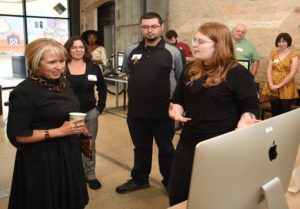
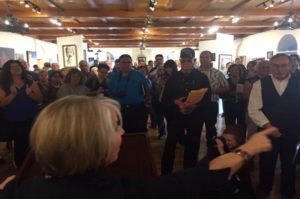
- Following the report two weeks ago regarding gunshots near campus, I met with members of Highlands Emergency Operations Team (EOT) to debrief on the incident. With any incident, there is always room to find improvements in our processes. The EOT identified two major areas where our response to emergencies could be improved: communication and awareness training. The team has already implemented several solutions in both areas, including scheduling expanded training for students, faculty, and staff. Some of the proposed solutions will require a financial commitment on the part of Highlands. I have not budgeted for that this year, but this is a high priority and we must try to find a way. The EOT, representatives from the faculty, staff, and student senates, and Vice-President Max Baca are working together to develop a proposal for our emergency infrastructure, which will be on my desk before the end of the month. I thank everyone involved in their continuing work to make our campuses the safest places possible for all of the Highlands family. I have unfortunately been through several “shots fired” incidents on different campuses where I’ve worked and even more unfortunately, I have dealt with numerous student deaths during my career. As you would expect, these are extremely tough for everyone, tragic beyond belief, and the things I worry most about in the wee hours. As I previously noted, each incident provides an opportunity to review the processes in place and to improve things. This last incident was no exception, but…I am very pleased with numerous aspects of our responses, particularly those of our campus PD. I also appreciate the kinds words about all this in the Optic (see: https://www.lasvegasoptic.com/content/thumbs-9272019?fbclid=IwAR1laB2IFcuy5GYhWv_8HwrzCC_2528xeb5cGLJnwqhreP34FFPrR7m26GM).
- We were recently informed by the HLC of the names of the three Peer Reviewers who will visit our campus for the Focused Visit on March 30-31, 2020. One is a clinical psychologist, one is a CFO, and one is a Professor of Management. All are experienced and have very solid academic credentials. I know the campuses these folks are from, but I nor any other key players involved in this personally know these individuals so all concerns about potential conflict of interest are eliminated. I will pass on more details of the upcoming visit as I receive them.
- I recently received the summary of our efforts to raise some funds during the Homecoming. We held a silent auction, a live auction, sold tickets to the Cowboy Lounge, sold t-shirts and other merchandise, etc. We made $7,300, which is good. Thanks to all who purchased tickets, bid on auction items, etc. and thanks to the numerous faculty and staff members who assisted.
- Dr. Daniel Chadborn’s new book, Meet the Bronies: The Psychology of the Adult My Little Pony Fandom, was recently published by McFarland books. The book explores fandom and group involvement and dynamics in the fan community. Congratulations to Daniel.

I’m recording the October installment of the Americana radio show next week. That will be an all Steve Earle show. To my incredible and loyal fan base of four people (that I know of)…look for it next week! The musical lineup (all by Steve Earle):
- Guitar Town
- Copperhead Road
- The Devil’s Right Hand
- Ellis Unit One
- I’m Still In Love With You (duet with Iris Dement)
- The Other Side of Town
Sam Minner,
President
Greetings colleagues. A brief update for the week September 23-27:
- The Governor will be on our campus next week. She’ll do a meet and greet in Kennedy on Tuesday, October 1 starting at 12 noon. Please drop by and say hello.
- I cannot express my gratitude to all of the HU folks who made last week’s Homecoming a success. These large events always require an enterprise effort and I know that many of those efforts are layered right on top of regular duties. So…..to everyone who played a role in this year’s Homecoming….thank you, thank you, thank you. The Erudite Parade Dog Bella (not looking too happy in that hat…BTW, dog on left…) thanks you as well!

- When was the last time you heard or read some national level good news story about education in New Mexico? Positive and hopeful things going on at any level of public education—preK, K-12, higher education, etc.? Well….here’s one—Free College In New Mexico: https://www.insidehighered.com/blogs/confessions-community-college-dean/attack-hedgehog. There have been several articles in national outlets about the Governor’s proposal. Here’s one from Forbes magazine: https://www.forbes.com/sites/wesleywhistle/2019/09/19/what-new-mexico-gets-wrong-about-free-college/#6e6aa4805d78. Here’s a clip from a local television station: https://www.kob.com/albuquerque-news/governorrsquos-free-college-plan-faces-backlash/5504287/. And another from CNN: https://www.cnn.com/2019/09/18/politics/new-mexico-free-college-tuition-plan/index.html. And a final one from a Yahoo outlet: https://finance.yahoo.com/news/critics-mexicos-proposed-free-tuition-160502668.html. I was particularly interested in this quote from the Yahoo article: “While student surveys show that financial struggles are one of the most common reasons students drop out, that doesn’t mean lowering tuition will automatically drive graduation rates up. In fact, a 2017 NBER paper found lowering tuition costs doesn’t lead to greater degree completion, but spending at colleges and universities does.” Here’s the link to a summary of the paper: https://www.nber.org/papers/w23736 and here’s the paper in toto: https://www.nber.org/papers/w23736.pdf.
- Here’s another positive story from inside our state: https://www.abqjournal.com/1369536/for-your.html.
- I spoke with Ms. Tina Clayton the other day and she briefed me on our international student cohort for the fall term. We enrolled 61 international students this fall from 24 countries. Nigeria, Pakistan, and Jamaica, were the nations sending the largest number of students to us. International students continue to decline on most American campuses. There appears to be a number of reasons for the decline including a backlog processing student visas and some concerns about how welcomed (or unwelcomed) foreign students feel in America these days. For more, go to: https://www.insidehighered.com/quicktakes/2019/04/23/international-student-numbers-us-decline. It is very gratifying to me that so many good HU colleagues work hard to make certain our international students are welcomed here. For an example, see: https://www.nmhu.edu/pakistani-exchange-student-appreciates-kindness-of-americans/,
- On Wednesday, it was a pleasure to welcome the Northern New Mexico Citizen’s Advisory Board to our campus. That important board provides input to a variety of agencies regarding environmental efforts at and near the lab. They meet monthly and hold their meetings at different locations around the state. This month, they met on our campus. Max Baca serves on that Advisory Board and was elected the new President of the Board at the meeting.
- A great Power Of Service session on Thursday. There were good discussions and a few skits focusing on providing better service to our students and…to each other (a strong Servant Leader idea). In addition, several of our colleagues were honored with special certificates of service to HU and monetary awards. I love this Power of Service program on our campus. It includes a high level focus on service (messaging by many people that this kind of thing matters here), some great training programs based directly on participant interests and needs, and thanks to the generosity of HU Advancement, an incentive program (cash awards for participation in the program, etc.). Frankly, most campuses I’ve been on do nothing in this respect. There’s plenty of talk about service to students and each other, but no real efforts to try to improve. The fact that we are doing quite a bit to improve (like this program) speaks volumes to our commitment to service. This work is never done. We all have stories about a lack of service and or attention to a student or one of our colleagues. But, you are either trying to work on this or not. We are…and I think that is a wonderful thing. Practicing good service to students and to each other can become a habit. When I repeatedly keep that in my head (and I often do not, I admit) it can become a big part of how you are perceived by others (e.g., “Here comes X who is always upbeat and I often feel something positive after we talk” compared to “Here comes Y and man…can I somehow escape that interaction?”). As Aristotle said, “We are what we repeatedly do. Excellence then, is not a single act, but a habit.” Well said Aristotle and of course, I am hardly the first person to congratulate him on his pronouncements. A few photos of the event in Ilfeld:
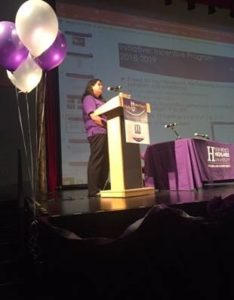
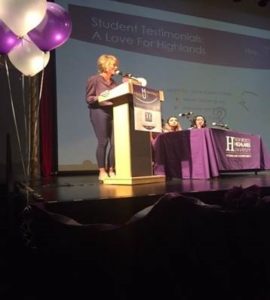
- Dawn Tucker, the Executive Director of FlagShakes (the Shakespeare troupe presenting Winter’s Tale on campus this week) had a great interview on the Richard Eed’s Show. Listen here: https://santafe.com/podcasts/dawn-tucker-of-the-flagstaff-shakespeare-festival-performing-winters-tale-nm-highlands. I’ve seen Winter’s Tale three times—once outdoors while in London and that was memorable. I’ve heard many times that a few early productions of the play used a real bear in the well-known “bear scene “ of the play. Not certain if that is true. Free performance of Winter’s Tale this evening at 7:00 in Ilfeld. Matiness tomorrow…also free.

The most recent Americana radio show (https://www.dropbox.com/s/bhxkzixgc1n012r/big-sam-show-number-2.mp3?dl=0) and by the way, is anyone enjoying the Ken Burns series as much as I am? Really great. The third installment of my radio program will be out this October.
Sam Minner,
President
On behalf of President Minner
Greetings colleagues. A brief update for the week of September 16-20:
- I am sure everyone is aware of the Governor’s new proposal to make college “free” for New Mexico students (https://www.npr.org/2019/09/18/762071931/new-mexico-unveils-plan-to-give-students-free-college-tuition-regardless-of-inco). The program would provide the “last dollar” allowing all New Mexican students to attend for free (after Pell, after lottery, etc.). The proposal has been referred to as the New Mexico “moonshot” for higher education. The devil is always in the details around these big proposals and we’ll see what happens, but…I have to say it was refreshing to hear such a grand and hopeful idea. As expected, some critics of the concept have already weighed in (particularly see the comments section in https://www.insidehighered.com/news/2019/09/19/doubt-and-hope-about-new-mexicos-free-tuition-plan).
- I was moved by this piece in the recent New York Times Magazine. Peruse if you’d like: https://www.nytimes.com/interactive/2019/09/10/magazine/college-inequality.html. I especially reflected this quote from the essay:
“Colleges have made racial and class diversity into virtues with which they welcome students during orientation and entice alumni to make donations. But students of color and those from lower-income backgrounds often bear the brunt of the tension that exists between proclamation and practice of this social experiment. Schools cannot simply showcase smiling black and brown faces in their glossy brochures and students wearing shirts blaring “First Gen and Proud” in curated videos and then abdicate responsibility for the problems from home that a more diverse class may bring with them to campus. Does this entail going beyond providing tuition, room and board? Yes. It requires colleges and universities to question what they take for granted, about their students and about the institutions themselves. And to do this, they’ll need more than an algorithm. What’s needed is a deeply human touch.”
- Our good colleague, Joe Zebrowski, recently returned from Mongolia where he did some GIS training and gave a talk about the great work going on at the Rio Mora. It sounds like it was quite a trip and I am certain he was a great representative of HU and New Mexico. A few photos of the fauna and flora of Mongolia:

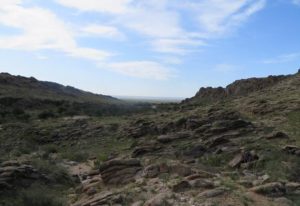
- Nice mention of Dr. Jesus Rivas and HU in the journal bioGraphic from the California Academy of Sciences. Take a look—just incredible photography: https://www.biographic.com/posts/sto/the-secret-garden.
- I had an interesting interaction this week with one of our new faculty (and someone relatively new to higher ed faculty life in general) and I was struck, quite frankly, by how academic life is perceived by this person. It has just been too long for me to remember all that, I guess, but he went on at some length about the “beauty” of his life. Beauty—his word. Teaching things he cared about. Making new knowledge in subjects he loves. Serving humankind. Associations with many other very smart and often like-minded people. Supervision that is so light to often go unnoticed. Opportunities for world travel (see above). On and on. He was correct…the academic life can be and often is a beautiful life. Is it always beautiful or perfect? Of course not, but it is a great life. Hundreds—maybe thousands—of people would do anything to have the jobs we have. We are lucky. I’ll try to personally remember that.
- On Wednesday, HU folks did some chile roasting on the patio of the SUB. Many thanks to Dr. Eric Romero and his team for the event. Chiles were roasted and our students dined on tortillas filled with that fresh roasted green from Hatch, NM. I’d like to see this event on an annual basis. I am hardly the first person to note that college students may or may not recall whatever class session they had on Wednesday, September 18 on the HU campus (believe me, they rarely recalled most of the classes I taught)…but I bet they will never forget the day they met friends to roast chile on the patio of the SUB. As Alexander Astin wrote in What Matters in College….what really matters? Well…everything. A photo of our chile loaded up in Hatch and some photos from the roasting:

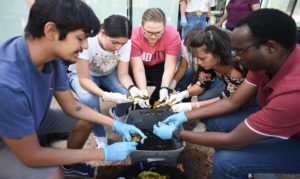
- Also on Wednesday and in honor of Constitution Day, a lively group of students met to play Constitutional Jeopardy. Co-sponsored by the Department of History and Political Science, the NMHU Libraries, HUE, ARMAS, Career Services, NMHU Recruitment, Campus Life, and other offices, students challenged each other on their knowledge of our Constitution and American history. During these days of hardcore instrumentalism and career focused education, it is too easy to forget the important ideals and goals of higher education put forth by Thomas Jefferson. Namely, a free nation requires an educated and engaged citizenry. Want to live free? Want to stay that way? The nation’s schools and particularly the nation’s system of higher education are at the center of that. Forgetting that or disregarding it puts us all at risk. Many thanks to Dr. Peter Linder for going the extra mile to organize the event. Speaking of Dr. Linder, there was a very nice news article about Jake Covington, the 2019 winner of the Forever Cowboy Student Award. Jake is a third-generation HU student, captain of our beloved Vatos, and grandson of Regent Frank Marchi. Jake wants to be a history teacher. His favorite professor—-Dr. Peter Linder. Everything that happens on campus matters to students (again, see Astin’s work), but the thing that matters most are the interactions between great faculty and students. No doubt.
- The most recent American radio show: https://www.dropbox.com/s/bhxkzixgc1n012r/big-sam-show-number-2.mp3?dl=0. The third installment is on the way.
Sam Minner,
President
On behalf of President Minner
Greetings colleagues. A brief update for the week September 9-13:
1. Thanks to everyone who attended the kick-off Sunday luncheon for the New Mexico Painter’s Exhibition and or the reception in Kennedy that followed the luncheon. We had great crowds for both events—I think about 200 people at the reception.
The show looks great and I encourage everyone to stroll through Kennedy to see it. It is free to all members of the campus and the general community. One of the paintings in the show:

2. I am very pleased to announce that HU was recently named by U.S. News & World Report as one of the most diverse regional universities in the Western United States. The publication employs a “diversity index” that measures the probability that any two people chosen at random (not including international students) from a given school are of different races or ethnic groups. It is a great privilege to work at a place where human diversity is so evident, but also celebrated in so many ways.
3. There’s been a little buzz this week about the American Sociological Association’s (ASA) new position that end-of-course student evaluations should not be used for high stakes personnel decisions like promotion, tenure, and or merit salary increases. Several other professional organizations have joined this movement including the American Historical Association and others. Why? Quite a few studies suggest that student evaluations are influenced, sometimes significantly so, by many factors including non-teaching variables like the time of the day the class is offered, if the class is required or elective, if the instructor tells funny jokes, and many others. Some studies even suggest that the physical attractiveness and or attire of the instructor influence these student ratings. Years ago, one of my own doctoral students completed a study looking at this and she interestingly found that instructors who were considered snappy dressers (think custom suits for men, high end business suits for women) and those who wore super casual attire (think shorts, flip flops and Ray Bans) were rated higher over time than those who dressed in a middle of the road manner (for men, think suits from a department store). She suggested that these findings were related to the “signaling” the students perceived (e.g., great clothing—a cool person who knows something about style; super casual dresser—someone who is so confident and probably so good at what they do that she or he doesn’t care what others think, but…someone who wears middle of the road clothes is trying to convince others that she or he is competent and credible and maybe they are and maybe they are not. I have no idea if any of this is true, but those were her conclusions. And, I should note that quite a few studies suggest that these end-of-course student evaluations are very often biased against women generally including a study I did many years ago (https://journals.sagepub.com/doi/abs/10.1177/088840648801100407). I really couldn’t believe how old that publication is—which is to say—how old I am. We use end-of-course evaluations here at HU, but I really can’t imagine anyone—a faculty member, an administrator, anyone at all—making an important personnel decision based mainly on student evaluations. They are important and I think it is appropriate to consider them, but surely other sources of evidence must be used and in all cases, you have to look for patterns and not put much stock in a single or a small number of ratings or comments. One of my professors at the University of Arizona, Dr. Lawrence Aleamoni (now Professor Emeritus), is probably considered the foremost expert in the evaluation of professors and I recall him exhorting me and his other students to look for patterns in those data and to basically disregard outlier ratings and comments. I have often wondered why we rely so much on proxy measures of teaching effectiveness when what really matters—or should matter, I think—is learning. Really…isn’t that only dependent variable that really counts? That is, have students actually learned something? How much? Can you prove it? I think those are good questions and yet, we really don’t take a look at that. I wanted to be liked by my students compared to being disliked, but being liked certainly did not and still does not trump how much is learned in the class. Also, is it possible to be very well liked (great student reviews) without much learning going on? I know that at least occasionally happens. I’ve seen it. In my faculty days, I frequently taught a second term statistics class and I taught students who had already taken the first class. The first course instructor was wildly popular—once won a teaching award at the institution—and yet, so many of his students did not really know much. A less popular professor’s students almost always did much better than students sent to me from the popular guy.
4. I enjoyed presenting my Learning Happens Here session this week. My topic was Man (and Women) in Black: the Legacy of the Carter Family. Participants from around campus enjoyed a nice lunch as they (hopefully) learned a bit about the Carters and their legacy. It was fun and nice break from my normal duties.
5. Very nice interview by Professor Heath Anderson on a recent Richard Eeds radio show. Here it is: https://santafe.com/podcasts/heath-anderson-on-business-entrepreneurship-programs-nm-highlands-university.
6. There’s been lots of attention this week on California Senate Bill 206—the so called Fair Pay to Play Bill. That bill would allow NCAA student athletes in California to be compensated for use of their name, image, and or likeness. The colleges and institutions those student athletes attend would not be involved in these business arrangements at all. There’s apparently plenty of support for this bill. It passed 72-0 and now the California Gov has thirty days to sign the bill or kill it. If signed, it would impact 24,000 student athletes in California. There is a long standing debate about paying student athletes in any way shape or form. Here’s a pretty good overview of the debate: https://www.collegexpress.com/articles-and-advice/athletics/blog/should-college-student-athletes-be-paid-both-sides-debate/. As expected, the NCAA has come out strongly against Bill 206. Their position is that NCAA sports should be totally and completely amateur—no money involved. Others suggest that the notion that “no money” is involved right now (or in the past) is a joke. Some assert-there’s plenty of money sloshing around, but some people are pretty good at occluding it. Another take on this whole issue has to do with who is benefiting from NCAA athletics. Top programs (think Alabama in football, Duke in basketball, etc.) make millions on sports programs. Student athletes, if all rules are followed, might get a scholarship, but actually earn nothing. NCAA sports have often been called a minor leagues for the pros. Pro teams pay nothing for this and, once again, student athletes earn nothing in the so-called NCAA minor leagues—if you want to call it that. Is that fair? Most student athletes…even very talented Division I athletes….do not win pro contracts and yet many of them devote a lot of energy to their sport. In too many cases, they graduate (or do not), do not have a pro career in front of them, and particularly if they do not graduate….return home without a degree and often very limited opportunities. That is a huge problem. Some, but not all, student athletes are from very poor backgrounds and face great fiscal pressures while they are in college and not earning a salary. And yet, their home institutions, in some cases, make millions. Is that fair? All NCAA conferences, including Division II, are carefully watching the situation in California. Some fear, if the California bill is passed, it will be the first step in actually paying student athletes a salary. As you might imagine, the NCAA is totally against that.
7. I received a lot of good feedback about things we might do to improve performance in regard to our students getting their books on time. Feedback is good, but ideas and recommendations are even better. One of my mentors—and a great university president—was fond of asserting that no organization could move to better outcomes by critique. You had to do something. At least try. Really good advice. I’ll get together with Bob, Kim, Roxanne, and others and see what we can do. If anyone has additional suggestions or recommendations, please feel free to send them to me. I did spend a little time examining this issue online and learned that the traditional bookstore model is rapidly fading. Today, many so-called university bookstores are basically selling t-shirts, sweatshirts and ball caps. In some cases, they are not even stocking materials like notebooks. I heard a few comments that our bookstore had no binders. I checked online and saw you could buy one for 109 pennies and receive it the next day. Wow. Retailers cannot really compete with that. Many university retailers are not even using the word “bookstore” at all. I love traditional bookstores, but ….change is inevitable I guess.
8. I attended the Los Alamos Community breakfast on Thursday morning. Numerous TRIAD officials (that’s the group now managing the Lab), Chancellor Janet Napolitano, and other officials also attended. There are few who can match Janet Napolitano’s resume. Napolitano is from New Mexico and graduated from Sandia High School. She graduated Phi Beta Kappa from Santa Clara University and then earned a J.D from the University of Virginia. She later served as the Governor of Arizona and even later, the Secretary of Homeland Security under President Obama. Really a remarkable person and yet, as down to earth and as accessible as anyone you’d meet. After breakfast, the colleges and universities in Northern New Mexico accepted a generous donation from the LANL Foundation. We’ll use these funds in support of students and K-12 teachers. A photo of the group accepting the check and another of our Lt. Governor, Howie Morales and UC Chancellor Napolitano.
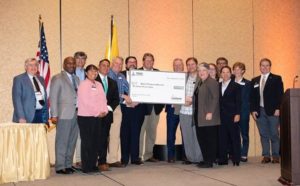
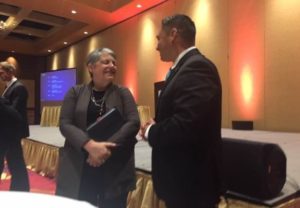
9. Please try to attend the Flagstaff Shakespeare’s production of Winter’s Tale on September 27 at 7:00 p.m. in Ilfeld or at 2:00 p.m. on Saturday, September 28. Both are FREE to all—including members of the community. Free to all…no cost at the door.

10. HU will be doing some chile roasting on Wednesday, September 18 from 1:00-5:00 p.m. on the patio of the Student Union Building. Come by and grab a bag of roasted chile to take home.

11. Here’s the second installment of the Americana radio show. Not sure when it will air on KEDP, but you can listen here now: https://www.dropbox.com/s/bhxkzixgc1n012r/big-sam-show-number-2.mp3?dl=0.
Sam Minner, President
Greetings colleagues. A brief update for the week September 2-6:
- I want to thank the members of the Search Committee for the position of Vice President of Strategic Enrollment Management (VPSEM). Those individuals are Jay Lee, Terri Law, Benito Pacheco, Susan Chavez, and Angela Meron. In my view, the search was very professionally handled. The finalists all commented on the care taken to make certain the search was done well and with close attention to detail. We attracted a strong pool of applicants and invited three finalists to campus for in-person interviews. After careful reflection, I decided to not offer any of the finalists the position. This is a very important position on our campus and doing everything possible to make the best selection is more important than filling the job and moving on. The latter is really never a good strategy. I previously stated that should the search not result in someone winning the job, I would then work with a search firm for a limited engagement to build a strong pool and conduct a second search. I have been on both sides of the table with numerous search firms and one thing they can do for you is to contact quality individuals who might not otherwise consider the job and talk with them about that possibility of doing so. Sometime that works. I am in the process of getting this arranged now. Some members of the original search committee have expressed an interest to serve on the new committee and some have elected to not do so. Having served on dozens of search committees over my career, I certainly understand both points of view. Service on these committees is very time consuming and layered on top of other duties. There’s only so much time in each day and people must make up their own minds about how much time they’ll devote to things. So, I will be reaching out to one or more people to serve on the new committee. In the interim, I will continue to serve as the Acting VP for Strategic Enrollment Management. The team there is strong and I am confident we can and will continue to push hard on the various initiatives already underway. Again, many thanks to Jay, Terri, Benito, Susan, and Angela. We are also making good progress on the search for a new Athletic Director. A strong committee is working closely with a search firm and the job description is now posted on several sites. Here it appears on one of those sites: https://www.womenleadersincollegesports.org/WL/Jobs/administrative/director-of-athletics-new-mexico-highlands-university.aspx. If your peruse the job announcement, you will see that the committee will soon be reviewing applications. This job (and in my experience, it is always true when it comes to athletic director vacancies) has attracted a great deal of attention and that bodes well for a successful search yielding a quality choice. It has helped that HU’s recent athletic performance has been positive. This from the vacancy announcement, “NMHU’s men’s basketball program is coming off an RMAC Tournament championship and an NCAA Division II Tournament appearance during the 2018-19 season. The NMHU women’s track and field program has been amongst the best in a very tough RMAC over the past decade, winning the RMAC Outdoor Championships and finishing seventh at the NCAA Championships in 2018 while collecting 11 individual national championships by five different athletes since the program started in 2006 – including an individual national championship from sophomore Annie Topal in the triple jump in 2019. This past season, NMHU baseball program produced the RMAC Academic Player of the Year, the RMAC Player of the Year and a third-team All-American in Auggie Francis while the NMHU football program is coming off its best season since 2012.”
- New HU colleague Susan Spano recently had an article published in the LA Times. The article highlighted the renovated Hotel Castaneda located right here in Las Vegas which, according to Allan Affeldt is “the prettiest town in the whole Southwest.” Well said, Allan. I agree. Here’s the article: https://www.latimes.com/travel/story/2019-08-30/new-mexico-hotels-las-vegas-castaneda.
- Debt—no one likes it, but many college students take it on these days. HU students are no exception. Despite being one of the most affordable institutions around and making numerous national lists of colleges graduating students with the lowest debt (https://www.valuecolleges.com/rankings/universities-lowest-student-debt/), many of our students still need financial aid of one sort or another to make ends meet. Our students are diligent about paying back their student loans. We’ve gone from a 2011 default rate of 16.2% to a 12.4% rate for our last student cohort. Things can always be improved, but that’s not bad and it is heading in the right direction. The whole school debt thing has been carefully studied and the issue is not always so much about how much a student borrows, but whether or not a student graduates. Put simply, students who graduate tend to repay their loans. Students who attend university, borrow some money, and then do not graduate tend to default. Take a look at the graphic below from the College Board. Thirty-five percent of students who defaulted on their loans owed less than $5000. Only 4% who owed more than $40,000 went into default. The takeaway—borrowing to attend college, if you must, is a good and probably a great investment in yourself, but….you need to graduate, enter the workforce, and start earning. Chances are if you enter the workforce with a degree you’ll earn more than otherwise. According to a May 15, 2018 study, the average weekly earnings for someone with a high school degree was $678. The average for a person with a baccalaureate degree was $1,137. Bottom line—you’ll probably be able to repay your student loans if you have a four-year degree. Leaving before graduation and taking whatever job you can get results in all kinds of problems including possible default on your college loans.
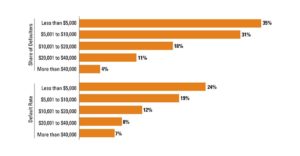
This week I received the first report of the semester regarding the financial awards we made to HU students. Our students received 7,990 awards (many received more than one). A few highlights: $1,019,912 dollars were provided under the Federal Work Study program. Approximately $5.5M were offered under the Pell Grant program. Our financial Aid office has the entire spreadsheet if you’d care to peruse.
- I also received our early performance in regard to retention. Our most recent fall to fall freshmen cohort retention rate is 55.4%. Our goal was 52%, so we exceeded our goal. I need to check, but I think this fall to fall retention rate is our best over many years. Congratulations to Benito, his team, and members of the entire campus community who continue to work hard to retain our students and serve them well. We have a nice upward trend going in regard to fall to fall retention (Fall 16-Fall 17 : 45.5%, Fall 17-Fall 18: 51.2% and Fall 18-Fall 19: 55.4%) so we are definitely on the right track. This work is never done…that mission is never fully accomplished…but given the three year trend (not merely a one year improvement), I think we can legitimately say we are doing things that make a difference. This fall we are adding some new elements to our retention efforts (e.g., Success Coaches) and hopefully, that will result in even more improvement in the retention rate.
- Please encourage people to attend the Field Day at the NMSU Research and Nursery facility in Mora from 9:30-3:30 on Saturday, September 14. You’ll learn a great deal about the challenges associated with preserving our forests and more than preserving them, making them healthier and more verdant. The event is free. The Research Station in Mora is located in the middle of town. There is small sign at the entrance. Also of note in that department, the GEOL 3250 class recently did a field trip to Elk Mountain. As reported by Dr. Lindline, the weather was great and the muscovite shined. We have many strong disciplines here at HU, but in my mind the NMHU Natural Resources Management Department is truly hitting on all cylinders. From strong connections with other disciplines on campus, to connections with other professionals and programs around the state, nation, and world, to grants, to high impact practices leading to high student engagement, and more, NRMD is really doing great things. A photo from the Mora Research facility and a couple from the recent Elk Mountain excursion:
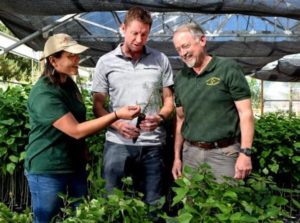
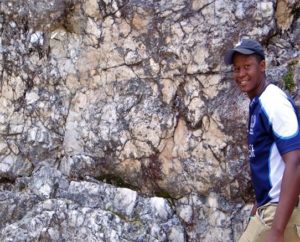
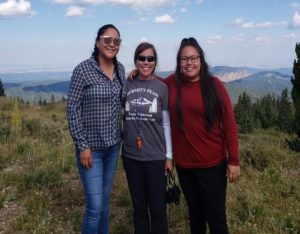
- Please try to attend a special concert on September 20 at 7:00 p.m. where our own inimitable Andre Garcia-Nuthmann will be the featured soloist at the “Zarzuela at the Plaza Ballroom” concert. A Zarzuela is a Spanish opera and the Zarzuela tradition dates back to the 17th Beginning Monday, September 10 at 12 noon, the President’s Office will provide free tickets to the first six students who request them from Dr. Minner’s capable assistant, Ms. Carolina Martinez. This event is not part of the Arts@HU series so is not free to students, but…at least six of them will pay nothing. Please pass the word to your students. A photo of our tenor vocalist, Professor Andre Garcia-Nuthmann:
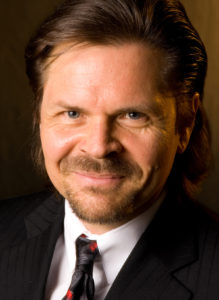
Andre García-Nuthmann
- New Mexico continues to face numerous challenges in the higher education sector. Overall higher education enrollment in New Mexico is down while it is up in nearby states (Utah, Texas, Colorado, and Arizona). Community college enrollment is pretty much down all over with the exception of slight increase in Texas. High School graduation rates are up in New Mexico—a good thing—but our rate still lags top performing states. A few other details from a recent New Mexico LFC report:
- At four-year research universities, freshman enrollment has been flat…
- At four-year comprehensive universities, freshmen enrollment declined by 5 percent. ENMU experienced the largest decline in freshmen enrollment among the 4-year comprehensive colleges…
- At two-year colleges, a 15.9 percent decline in freshmen enrollment has been most acute at the independent community colleges…
To me, the most critical question is….if the cost of tuition is lower in New Mexico than other states (and it is…as a state, we have one of the lowest tuition rates in the nation; for example, lower than schools in Texas) and if the economy in some states is actually stronger than it is here in New Mexico (and it is …again, e.g., Texas), why are more students in other states attending college? Other states are outperforming us in regard to college enrollment and frankly, that puts our state at risk. Why? What gives? We already have low tuition rates. Our students graduate from NM colleges and universities with some of the lowest debt in the nation. Our economy is decent, but it is better in some other states which would suggest that students in those states could be lured away from higher ed in order to enter the workforce. And yet, that is not happening. Again, what gives? I have some thoughts about that, but I am interested in your ideas.
- I hope you are able to attend our first football game this Saturday. We take on Ft. Lewis at 1:00 p.m. at Sanchez Field. The New Mexico Highlands football team was picked to finish seventh when the RMAC released its preseason poll. The Cowboys were picked to finish last in 2018, but finished tied for sixth place so we certainly outperformed expectations. The 2018 season brought the most wins for the program since 2012. Under Coach Fine’s leadership, the Cowboys are definitely on a upward trajectory. Let’s see what 2019 holds for the Cowboys.
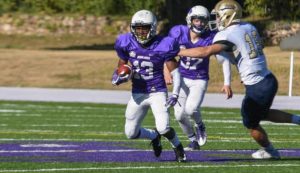
- This Sunday, HU will kick off the 6th Annual New Mexico Painter’s Exhibition with a luncheon for artists and other invited guests at the Hotel Castaneda. A reception in Kennedy will follow the luncheon. The show will run through October 31. The show is open to all—no admission at the door. Please make a point to see this very special and exciting show. In these times of incivility and so much coarse behavior all around us, let’s celebrate great art. It makes the human spirit soar and we could use some of that.
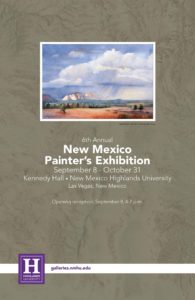
- Still working on the second installment of the Americana Radio Hour. I’ll let everyone know when it is done.
Sam Minner,
President
Greetings colleagues. A brief update for the week of August 26-30.
1. An intrepid group of students, staff, and faculty members arose early last Saturday morning to hike Hermit’s Peak. I (the less than intrepid one) also arose early to see them off—hardly something to brag about, but I did get up early. We filled an HU bus with about 24 people and a good time was apparently had by all. Two photos from the peak. Wow, what a view.
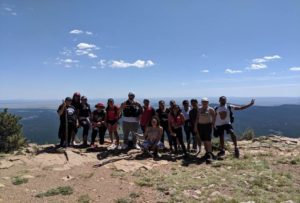
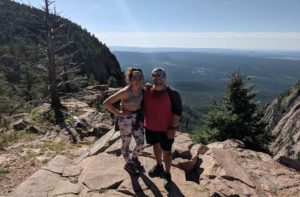
2. This has been a busy week on campus with a variety of welcome back and other social events. Operation Glow (a rave at Melody Park), the Native American Student Dinner, the Welcome Back Beach event, the first meeting this fall of the NMHU Esports Club, and many more attracted nice crowds of students, faculty, and staff. For example, 22 students and 19 faculty and staff attended the Native American Student Dinner. Many thanks to the students who attended and the numerous faculty and staff who supported our students by also attending the event. A few photos from the Native American dinner and one from the glow rave—which I did not attend, obviously.
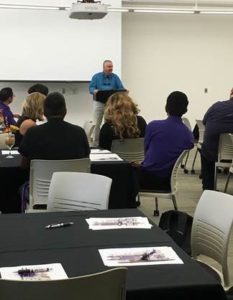
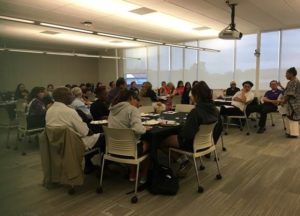

3. We held the Executive Management Team meeting this week and began the meeting with a discussion of conflict in the workplace. We had a good discussion after reading this article from Forbes: https://www.forbes.com/sites/mikemyatt/2012/02/22/5-keys-to-dealing-with-workplace-conflict/#190a26231e95). Everyone has experienced this. It is merely a question of degree. And yet, I’ve known so many people who leave an organization or maybe even retire because of the challenges they face with work conflict. Also, I know that those issues are common in virtually every work environment. Higher Education does not have a corner on the market. People talked about how they deal with conflict, strategies they use to cope with it, and when enough is just enough and they makes some life and or career change. There was a discussion of one common technique referred to as “what would it take for this person (someone causing my work stress) to prevail—maybe even “win” and move on? I’ve used this technique myself and it has been helpful at least some times. I actually say—out loud—what I think the other person’s position is. Maybe I agree with it. Maybe not. But, to articulate the position, as best I can, and then try to verbally defend it, again as best I can, has sometimes been helpful. A few times it has helped me gain some additional understanding of the other person’s point of view. Others around the table shared approaches they use to deal with conflict. We moved on after that to some routine personnel items, how we might improve out summer school performance, and how often the EMT should meet to be effective and efficient.
4. Beginning last year, I sent out a brief happy birthday email to students and HU faculty and staff. Thanks so much to University Relations for that idea. It was really well received and we’ll do it again this year. I saw this year’s spreadsheet for student birthdays and…we have one student who is 91, 16 students in their 80s, and 5 who are 17. Of course, many students are in-between those ages. HU—-where we celebrate human diversity in all forms—including age.
5. Kudos to one of our newest faculty members, Dr. Justine Garcia, on her most recent publication in the top journal Ecology. Dr. Rivas brought this important accomplishment to my attention and I thank him as well.
6. There have been many discussion over the years about HU faculty, staff, and administrators residing (or not residing) in or very near Las Vegas. I asked our HR office to get me some information about what the status of all that is today. One of my mentors once told me that higher education was a seething crucible of rumors—so, in this case, what is the truth? According to their report, about 326 people (that’s faculty, staff, and members of the executive team) live in Las Vegas. About 142 live elsewhere. In other words, about 70% of HU employees from those groups previously noted live in or near Las Vegas and about 30% do not. I should also note that, at least in the case of some faculty and staff, they have an office…that is, their place of work… is not Las Vegas at all. They work in Santa Fe, Rio Rancho, or even Farmington so it makes no sense for them to reside In Las Vegas. But still, overall, we are at about a 70-30 ratio of HU folks who reside here and those who do not. So, is this a “problem” at all or a kind of perceived or manufactured problem? The potential benefits of living close to one’s work are well known. Shorter commutes reduce the chances of getting in an accident. Commutes can be stressful and adding another 90 minutes (or more if you reside in Rio Rancho or Albuquerque) just adds to your time away from home. Driving less is environmentally friendly. The benefit list goes on and on. I saw results from a recent survey that 220 million Americans average an hour and a half each day in their cars and more than half of them asserted that their commute significantly added stress to their lives. I once had a two hour commute (each way) to my work. Four hours added on to my workday was tough. About 3.3 million people travel at least 50 miles to work one way, according to the Bureau of Transportation Statistics. So, across the nation, lots of Americans spend a lot of time getting to and from work. University employees are complete people with all kinds of special life requirements, preferences, and interests. In the four years I’ve been here, one faculty member wanted to reside in Las Vegas, but had a special health issue requiring numerous treatments not readily available in Las Vegas. Another had a child with very special health and educational needs and she thought those needs could best be met in a larger city. Another had inherited a home in Santa Fe and was not interested in selling that home and purchasing another one just to be closer to work. Still another found that the church he routinely attended was not in Las Vegas, but was in Santa Fe. That was important enough that he chose to live in Santa Fe. Not Las Vegas. It is true that some municipalities actually require certain employees (e.g., police, first responders, etc.) to reside in the city they serve and that makes sense to me. You don’t want someone to drive 45 minutes to get to an accident scene or put out a fire. But, it is not quite the same situation, at least in my head, to “require” someone to reside in the city in order to…what…attend a basketball game? It would be nice to see them there, but the advantages of having them there are surely outweighed by some of the real life issues I noted above (e.g., a child’s care, the ability to practice one’s faith, etc.). So this is what I’ve done—in recent years, I have required executives to reside in or near town. Given their job responsibilities, I think it is best if they are close and available as things come up. For example, we are now searching for a new Vice President for Strategic Enrollment Management and a new Athletic Director. Both will be required to live here or near. I have not required other HU employees to live in town…for the reasons noted above. Human beings are more than employees and if they believe that it is in their best interests (or their families’ best interests) to live in a certain location, far be it for me to suggest otherwise. Instead of requiring someone to live in a certain place, my preference is to work on incentives or local conditions to encourage someone to live there. Could HU, for example, engineer some programs that would provide financial support to encourage new employees to reside here? Are there residential options in Las Vegas that “work” for HU employees? Does the university or the community have a plan to specifically welcome newcomers to our community? Do community agencies and services (e.g., schools, the local hospital, local governments, etc.) host sessions to answer the questions by new arrivals? Does anyone maintain information potentially relevant to trailing spouses or partners, thus providing some possibilities for employment of those spouses or partners? My colleagues, what might we do to organize these kinds of programs? In sum, let’s not spend a lot of time complaining that “too many” HU employees don’t’ reside here, particularly given what I discovered that the majority of them actually do. Instead, let’s concentrate on making Las Vegas somewhere people want to reside. If we accomplish that, the 70% number should improve.
7. The Chronicle of Higher Education Almanac came out this week and as usual, it is full of data about higher education in the nation and to some degree, here in New Mexico. I know that several departments and other units on campus have a Chronicle subscription and , of course, the library also has a subscription. If you are interested in perusing, check it out. A few facts from this year’s Almanac:
a. master’s institution with the highest average pay for full professors: Pennsylvania State University School of Professional Studies ($140, 066)
b. lowest student to faculty ratio among four year public institutions: University of Tennessee Health Science Center (7:1)
c. highest paid executive at a public college: William McRaven at the University of Texas System ($2,578,609)
d. highest paid executive at a private institution: Ken Starr at Baylor University ($4,946,996)
e. highest enrollment of a public master’s university: U. of Maryland Global Campus (59,379)
f. college with the most online students: University of Phoenix (101,938) g. highest median wages at midcareer by major: pharmacy ($115,000)
h. lowest median wages at midcareer by major: early childhood education ($41,000)
i. college with the highest endowment: Harvard University (approx. $38B)
j. largest individual private gift to higher education: Michael Bloomberg ($1.8 billion to Johns Hopkins)
k. projected new high school graduates across the nation for the period 2019-2030 (-4.1%)
8. I have the second installment of the Americana radio show lined up, but haven’t recorded it yet. Here’s the show from last week: https://www.dropbox.com/s/lxlbyto22j1tb2e/Sept.mp3?dl=0. Sam Minner, President
Greetings colleagues. A brief update for the week August 19-23.
As always, if you prefer to not receive these messages, just let me know. I should note that one, but only one, reason I send these out is to help me recall things in preparation for a book I will write at some point. My working title at this point is Blue Collar and Ivory Towers: My Life In Higher Education.
- Dr. Josh Sloan recently appeared in an episode of The UnXplained on the A&E network. The episode, Unnatural Nature, focuses on some very odd crooked trees in Poland’s Crooked Forest. Here’s the link to the UnXplained show: www.history.com/shows/the-unexplained. I think you have to have a subscription to actually see the segment, but I accessed it through my Netflix account so I know it is possible to do it that way. Well done Josh. Why do the pine trees in the Crooked Forest grow that way? No one really knows. A photo of the Crooked Forest:

2. Sticking with the tree theme, one of our new biologists, Dr. Eric Griffin, was recently featured in a Smithsonian publication. His research pertains to bacteria appearing in tree saplings in Panama. Check out page 3 of the publication attached SERC-EDGE-Summer2019
3. We’ll see where our overall enrollment lands on census day—transfer students and other groups of students are challenges at this point—but on the first day of class this fall term, our new freshmen enrollment is up 2.3%. Decreasing population in our main recruitment area + a booming economy where it is easy to get a job (maybe not a good one, but a job nonetheless) and…still up by 2.3% among new freshmen. Well done to everyone who worked so hard to make this happen. It appears that the trend to see upticks in freshmen enrollment might occur across the New Mexico higher ed sector. If freshmen classes across the state do indeed increase, that bodes well for overall enrollment increases in the coming years. Here’s a story about UNM’s incoming freshmen class: https://www.kob.com/albuquerque-news/unm-predicts-increase-in-freshman-enrollment/5444694/).
4. I am very pleased to announce that we have recently deployed 64 new Dell computers in classrooms around the campus. Thanks to Joe Gieri and his team for a job well done.
5. Please take a minute or so to peruse the results from the recent administration of the NSSE. A summary is attached 2019 NSSE Executive Summary. There are lots of good data in the report and of course, there is always room for improvement. But, I am very pleased overall. The key finding for me: 83% of first-year students and 89% of seniors rated their entire educational experience at this institution as “excellent” or “good.” I think that speaks volumes for the work so many people are doing here to serve our students at the highest possible level.
6. I’ve had several recent questions about the number of faculty we support here at HU and related questions like the ratio of tenured/tenure track faculty to adjunct faculty. I asked Dr. Allard to check that out. Here’s what he found over the last three years (2016, 2017, 2018). Since 2016, we’ve remained steady in regard to full-time faculty (133 in 2016 and 133 in 2018). We’ve reduced tenured and tenure track faculty by 4 (from 93 to 89). Full-time non tenure track faculty have increased a few (from 40 to 44) and the number of part-time faculty has been reduced by 6 (from 119 to 113). Many of those part-time faculty work in our Social Work program and do clinical supervision type things. Overall (consistent with how IPEDS counts things and how it is reported to IPEDS) we’ve gone from 173 FTE faculty in 2016 to 171 in 2018. I should also note that, according to the AAUP, about 73% of all faculty working in American higher education are off the tenure track.
The massive national shift from faculty in tenured or tenure track positions to part-time or adjunct professors is undoubtedly one of the most significant changes I’ve seen in my own academic career and where things will ultimately land is anyone’s guess. However, I don’t think I’ve heard a single voice suggesting that this trend will change. So, we should all probably think very carefully about it. What to do? The most common concern I hear about this “adjunctification” is that academic freedom is at risk and I think that is probably true, at least to some degree. The whole idea of tenure was to protect academics from the vagaries of opinions and ideologies about what should be taught and studied (and, I might add, to lure very smart people into the academy where people were relatively poorly compensated compared to other professions with lots of very smart people (e.g., medicine). But, to me at least, an equal concern is the treatment of part-time faculty. It is one thing to teach a single class because you love teaching so much or you retired maybe a little too early and miss the classroom or something like that. I saw that kind of thing from time to time when I was a young assistant professor and a few of my retired friends still do that. I know one person who literally takes no pay at all to teach once course per year. By the way, convincing the university where he teaches to not pay him anything is a really interesting story. But, today…in 2019…many adjunct or part-time faculty desperately try to cobble a career together teaching on a part-time basis at 2 or more different schools…sometimes many more than two. They are paid low wages. They often have minimal or no benefits including health benefits and in some cases, are marginalized in so many ways (e.g., poor or no office spaces, not particularly welcomed at faculty events or included in governance or deliberative bodies, minimal opportunities for any kind of real advancement, etc.). I try to keep track of issues on the minds of adjunct faculty members by reading a couple blogs. Here’s one I look at frequently: https://www.adjunctnation.com/.
Here’s an interesting tidbit. I recently asked three new HU colleagues (on the tenure track here, but not yet tenured) how much additional compensation (if any amount) it would take to forfeit their tenure track positions. That is, if they could be paid more—today—would they trade that compensation for coming off the tenure track? Get this—incredibly (to me, at least) they all said they would…if, they could have multi-year (but not tenure track) contracts. One said he/she would go with a 3 year deal + $7500 more per year in compensation. One asserted that the switch could be made for a multi-year deal (not specified how many years, but thought about five) and maybe 10K more. One said he/she would probably do the deal, but had to think about how long the multi-year contract would be and how much more compensation would be required. I asked if they felt coming off the tenure track might impede their academic freedom. None of them really seemed very worried about that. I have to say, I was more than surprised by their responses and I also wondered how powerfully this kind of thing is felt both here and in the academic sector generally. I only asked three people, so I’m not suggesting that I uncovered some overall trend. Maybe I or someone should look into this further. I tried to find a study or two about this (what would it take for you to give up your tenure-track position?), but I couldn’t find anything at all. If the faculty wanted to do a brown bag discussion focusing on tenure in 2019 and beyond, I’m game and will find the necessary resources. The responses reminded me a bit of a situation I faced a couple years ago. I was on the job market and I was a finalist for a job at a shiny new campus….a campus literally being constructed in a very desirable location. I won’t say more but think blue water and palm trees. The thought of filling up blank pages with new programs and new ideas coupled with that desirable location was very appealing to me. I interviewed for an administrative job there and got the offer. As I always have (up until my job here at HU), I requested a tenured faculty job in the event I wanted to or had to move to the faculty. I was told—no one at the school had tenure. No one. Faculty were offered multi-year contracts—no tenure. The shorter the multi-year deal, the higher the annual compensation. Take a two year deal and earn 75K per year (just making that number up). Take a three year deal and earn 70K. You get the idea. After the term of one’s contract was up, you could negotiate another contract—possibly—but it was not a foregone conclusion you’d be offered one. I said no to the job. I had kids at home, a mortgage, and things were really pretty much in flux on the campus. When I was offered the job, my boss was in an interim position and I was told she would not be there long. So, I really had no idea who my boss would be. So, no. Then things started to get interesting. The university offered me more money, but still…no tenure. I said no. I got another offer. Even more money. Again, no. Finally, I said OK if I could get a long term faculty contract—ten years. I said I’d take the lowest possible rank—I didn’t’ care if I was an assistant professor— t the highest possible salary for that rank thinking I’d be able to easily move up in rank as I had done other places. I really thought they might do that deal, but in the end, they took a pass as did I. That one is going in the book.
I have tried to be clear on my personal stand in regard to tenure. If I have not or you are unaware, I offer this op-ed from 2017: https://www.abqjournal.com/1029357/three-flawed-suggestions-for-better-colleges.html. I followed that piece up in 2018 by writing about three more bad ideas. Here’s a bit on that: http://www.afa-srjc.org/Misc/importance_of_unions.pdf. I try to also offer what I think are good ideas—here’s my last piece from a few months ago: https://apnews.com/bcd1397ed86b47258703945247af9f40.
At any rate, this semester I will be reaching out to our part-time and adjunct faculty to learn of their concerns, issues, and suggestions for improvements. Those colleagues do wonderful things for HU and frankly, we could not do what we do without them.
- Good news….our residence halls are filled and we opened one wing of Connor to accommodate additional students. Many thanks to Ms. Yvette Wilkes and her team for efficiently getting everything prepared and in good shape for our students in residence. A photo of the inimitable Ms. Wilkes:
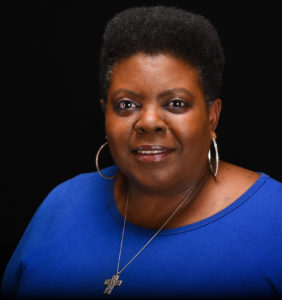
Yvette Wilkes
- Good news from HU Advancement. A generous donor left us a half-interest in a home here in Las Vegas and it has recently sold. I think we’ll accrue about 25-30K on our half-interest. Yet another donor has left an out of state home to us and we are awaiting an appraisal on that one. Finally, two very generous donors are leaving an 800-900K home to us. Well done to the Advancement team.
I’ve had a few people—don’t want to exaggerate—three—ask me when the “poem of the week” would fire back up. Well…they will not be fired back up at all. To those three valued colleagues and friends…sorry. In the place of those wonderful poems, I offer Big Sam’s Americana Radio Hour. I am recording these in our beloved KEDP studio and I’ll do one or two each month. It is nice to spend at least a few minutes doing something purely for fun. Each show will focus on some dimension of Americana music. What’s Americana music, you may ask? Good question. Tune in and listen to me dodge any kind of real answer to that question. There are some Americana radio stations (e.g., https://www.accuradio.com/americana/?name=The%20Train&b0=Alt-Country&b1=Americana&b2=Folk). There is an Americana Top 100 list (e.g., https://www.officialcharts.com/charts/americana-albums-chart/). There’s an Americana music awards show (e.g., https://americanamusic.org/awards). There’s a few Americana music publications (here’s a good one: https://www.nodepression.com/). But, defining the genre has eluded many of the even most dedicated journalists and fans. I guess I really don’t care how it is defined. Here’s the first show if you’d care to listen: https://www.dropbox.com/s/lxlbyto22j1tb2e/Sept.mp3?dl=0).
